Brazil, Part 1: The start of the TransAmazonica
— Amazon, Brazil, South America — 15 min read
August 13 - 16, 2010
After the preparatory journey across the Bolivian pampas, I was excited to be entering the allure that is Brazil, the largest country in the region and one of the pillars of the new Global South power regime. Apart from being the only Portuguese-speaking country in Latin America (and thus Brazilians not being considered Hispanics), the Brazilian culture feels different from the rest of the region. Perhaps it's due to its strong economy and the development that it has brought to its people or perhaps it's the immense fertile land and long, luxurious coast line that helps define the people of this area. Being identified primarily with the Amazon as opposed to the Andes that touches most of the other Latin America countries also aids in creating the distinction.
The difference I noticed right away was the warmth of the people, a kind that I haven't noticed from the general populous in other countries, so far. Not that I haven't met amazingly warm and beautiful people in all the countries that I've traveled through, but a good vibration seems to be emanating from all Brazilians.
The biggest attraction in Brazil for me was the Amazon. After reading about these lungs of our planet and the damage being done to them, I had an urge to see for my own eyes. I also had a good friend staying for a year in Brazil and I figured it would be a good place to take a few weeks break from the trip. Spending these three months in Brazil was also a good way to wait for summer to arrive in Patagonia, where I'm headed next.
I crossed at Guajara-mirim to begin on the west end of the fabled TransAmazonica highway cutting across the Amazon jungle to civilization on its eastern end. After a few weeks off in Sao Luis, I headed down the coast to Sao Paulo to take care of some things and then relaxed on the beaches on the way to Rio. From there, I turned south for Argentina.
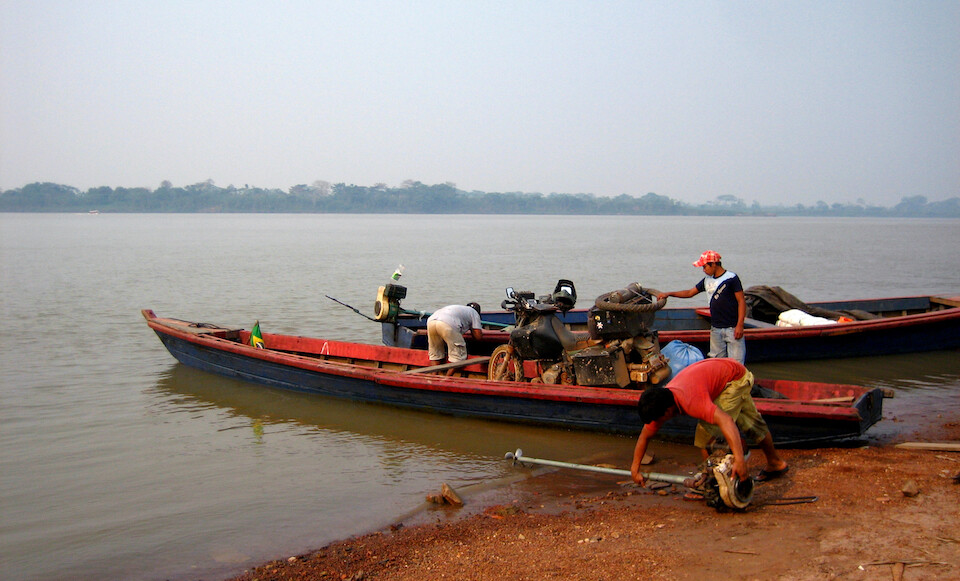 Brazil borders all the countries in South America except Chile and Ecuador and most of them have their borders in the Amazon. I crossed from Guayaramerin, here in Bolivia across Rio Guapore to Guajara-mirim in Brazil. Being my second canoe trip with the bike, I was now more familiar with how to load the bike and keep it balanced. The boatsman removed his outboard motor with the long propeller shaft and using a ramp, sanDRina was pushed in.
Brazil borders all the countries in South America except Chile and Ecuador and most of them have their borders in the Amazon. I crossed from Guayaramerin, here in Bolivia across Rio Guapore to Guajara-mirim in Brazil. Being my second canoe trip with the bike, I was now more familiar with how to load the bike and keep it balanced. The boatsman removed his outboard motor with the long propeller shaft and using a ramp, sanDRina was pushed in.
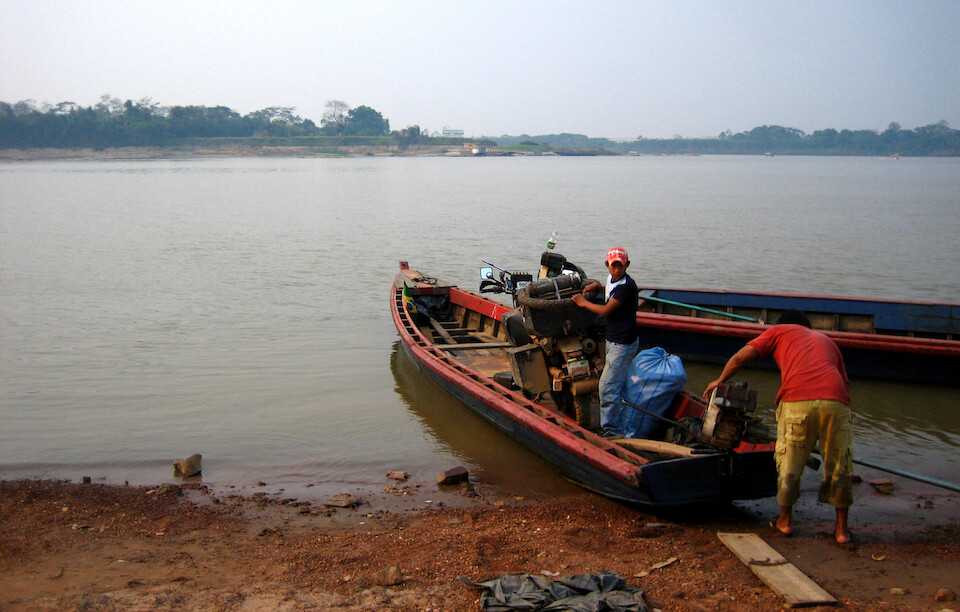 I made a deal with this Brazilian boatsman to take me across for 40 Bolivianos (10 Brazilian Reals, USD 6). He accepted my initial offer since it was towards the end of the day and he would be returning home empty otherwise. There's a brisk trade going on between the border towns with Bolivians importing nicer commodities from wealthier Brazil, and sending over less pricey clothes and other items since things are more expensive across the river.
I made a deal with this Brazilian boatsman to take me across for 40 Bolivianos (10 Brazilian Reals, USD 6). He accepted my initial offer since it was towards the end of the day and he would be returning home empty otherwise. There's a brisk trade going on between the border towns with Bolivians importing nicer commodities from wealthier Brazil, and sending over less pricey clothes and other items since things are more expensive across the river.
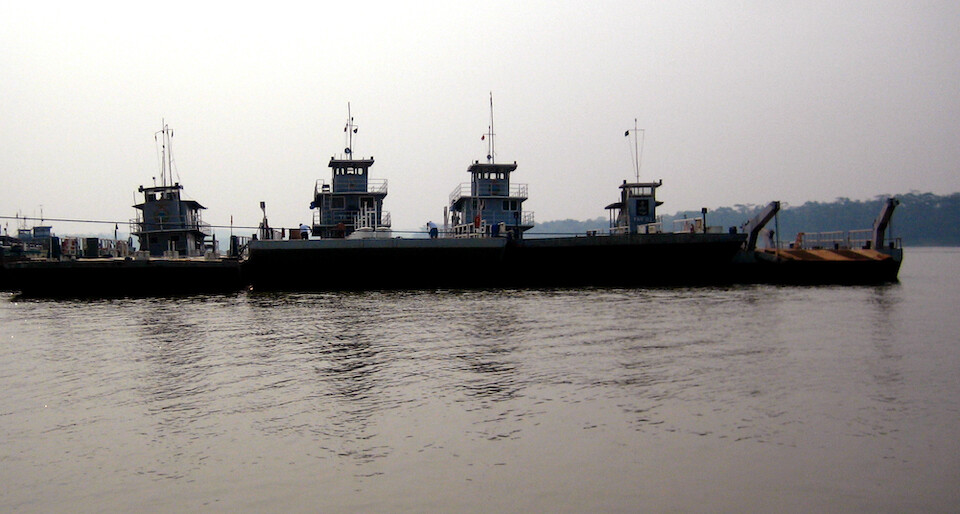 At the docks sat these grand vehicle ferries that were chained up, but being cleaned. I was told they run about once a week or even less, since there's very little demand for vehicle traffic across this border (besides all the illegally smuggled Brazilian cars into Bolivia).
At the docks sat these grand vehicle ferries that were chained up, but being cleaned. I was told they run about once a week or even less, since there's very little demand for vehicle traffic across this border (besides all the illegally smuggled Brazilian cars into Bolivia).
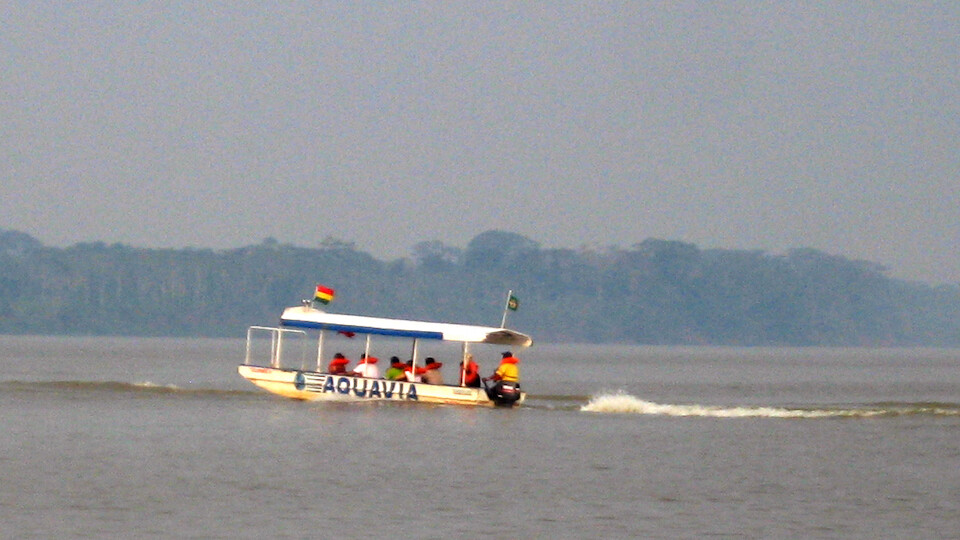 But human ferries were in abundance with Brazilians rushing over to buy some cheap items in Bolivia, have a cheap lunch and then rush back.
But human ferries were in abundance with Brazilians rushing over to buy some cheap items in Bolivia, have a cheap lunch and then rush back.
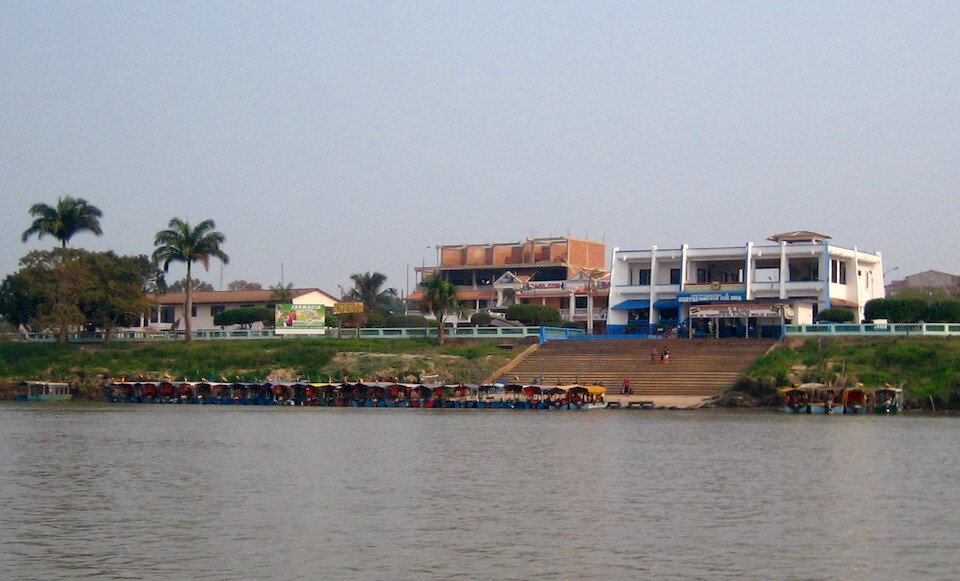 The passenger terminal on the Bolivian side.
The passenger terminal on the Bolivian side.
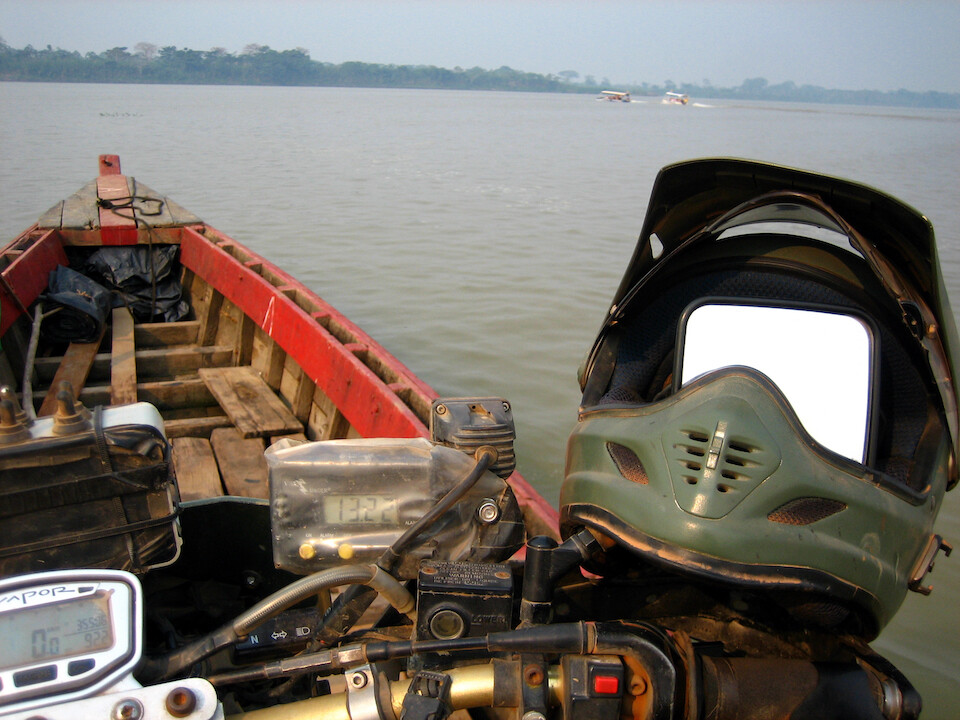 Racking up some more water miles with sanDRina. I sat on her to keep her balanced.
Racking up some more water miles with sanDRina. I sat on her to keep her balanced.
 Going around this rocky out crop with the sun fading.
Going around this rocky out crop with the sun fading.
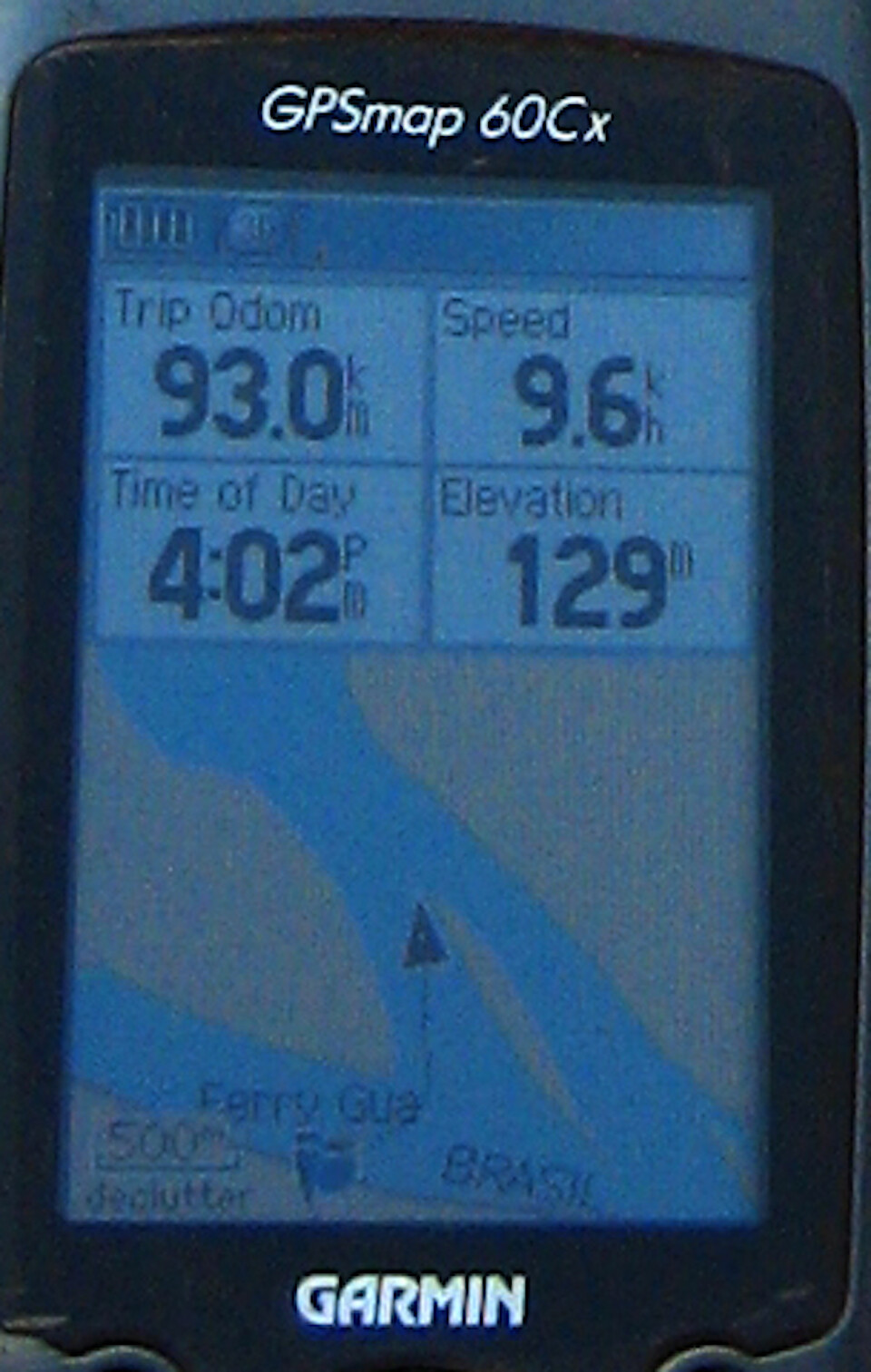 A GPS map of the crossing.
A GPS map of the crossing.
 Ahoy, Brasil! The river level rises during the rainy season, so maybe these old boats are waiting for the good water.
Ahoy, Brasil! The river level rises during the rainy season, so maybe these old boats are waiting for the good water.
 On the canoe with my steady boatsman, nice guy. All passengers are required to wear a life vest, but I guess the skippers are exempt.
On the canoe with my steady boatsman, nice guy. All passengers are required to wear a life vest, but I guess the skippers are exempt.
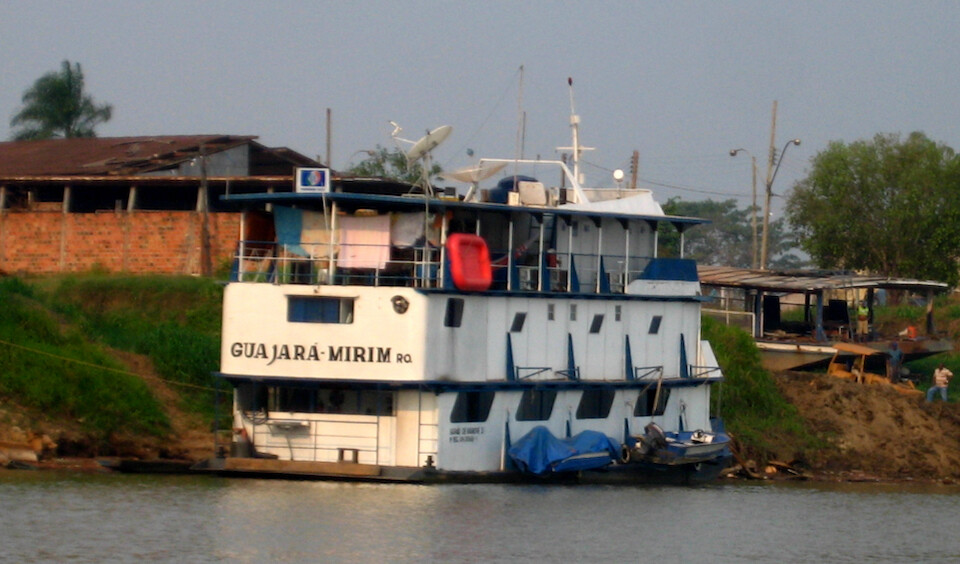 A boat house near the Brazilian coast. Would be nice to tour the Amazon on a boat like this.
A boat house near the Brazilian coast. Would be nice to tour the Amazon on a boat like this.
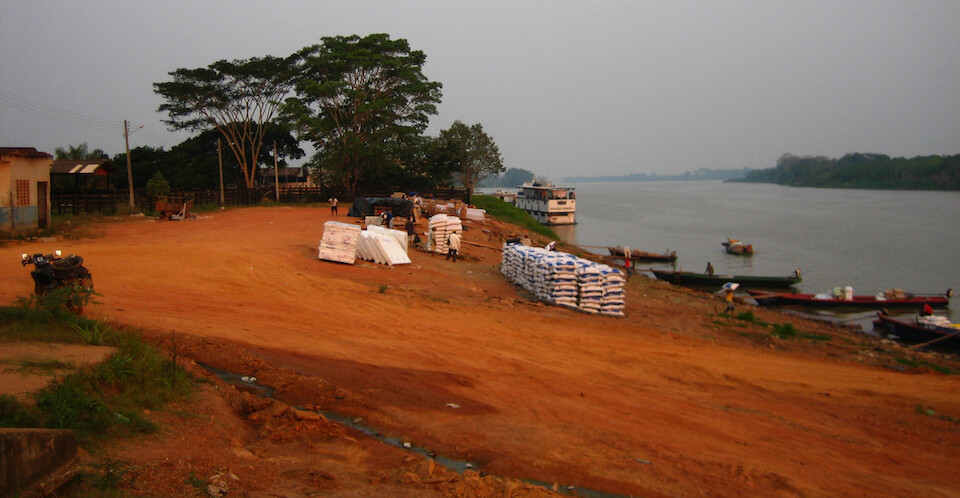 Riding the sandy bank up into Brazil after struggling with a tip over while backing the bike out of the canoe. I also think I damaged my already weakened clutch some more on this steep, sandy climb.
Riding the sandy bank up into Brazil after struggling with a tip over while backing the bike out of the canoe. I also think I damaged my already weakened clutch some more on this steep, sandy climb.
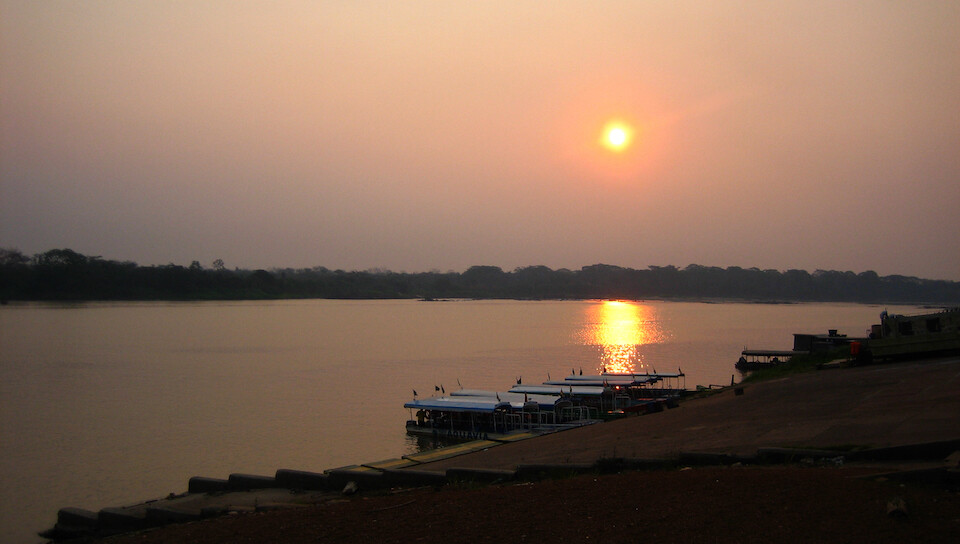 I got delayed on the Bolivian side since the customs office was closed from noon to 3 pm, so the sun was setting as I arrived in this new country. Not ideal, since time is needed to do all the appropriate paperwork, but I got it all done in time. Not being a regular land border, the offices needed are not all located nearby. I walked to the Federal Police station to process my immigration into Brazil, then over to the nice guys at customs to process the bike in. The head official was quite impressed that I was entering by motorcycle and treated me quite well with coffee and some snacks. I was already feeling very welcome and comfortable about being in Brazil.
I got delayed on the Bolivian side since the customs office was closed from noon to 3 pm, so the sun was setting as I arrived in this new country. Not ideal, since time is needed to do all the appropriate paperwork, but I got it all done in time. Not being a regular land border, the offices needed are not all located nearby. I walked to the Federal Police station to process my immigration into Brazil, then over to the nice guys at customs to process the bike in. The head official was quite impressed that I was entering by motorcycle and treated me quite well with coffee and some snacks. I was already feeling very welcome and comfortable about being in Brazil.
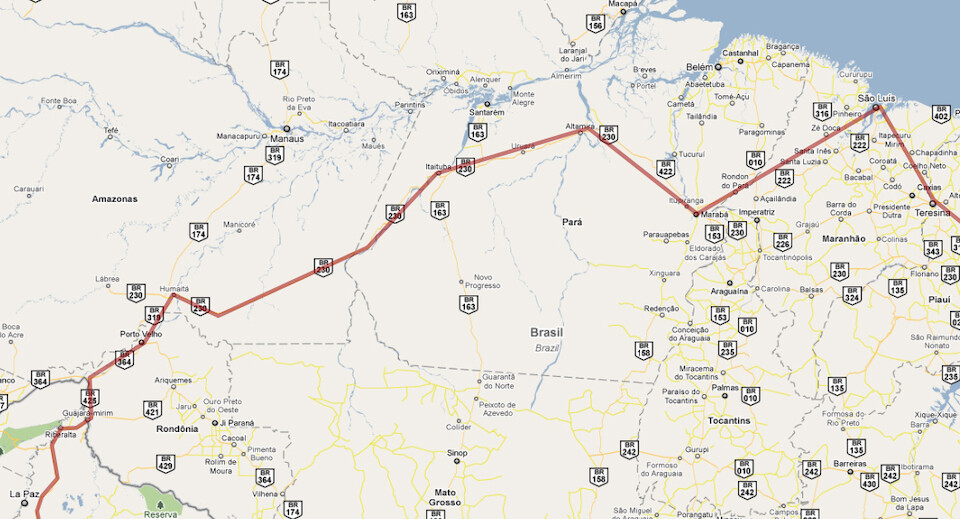 My route map across northern Brazil, entering near Porto Velho and taking BR-230, the TransAmazonica Highway across the jungle to Sao Luis on the coast, a 3,500 km (2,170 mi) journey with about 60% of that being dirt roads. Click on it to go to the interactive version in Google Maps.
My route map across northern Brazil, entering near Porto Velho and taking BR-230, the TransAmazonica Highway across the jungle to Sao Luis on the coast, a 3,500 km (2,170 mi) journey with about 60% of that being dirt roads. Click on it to go to the interactive version in Google Maps.
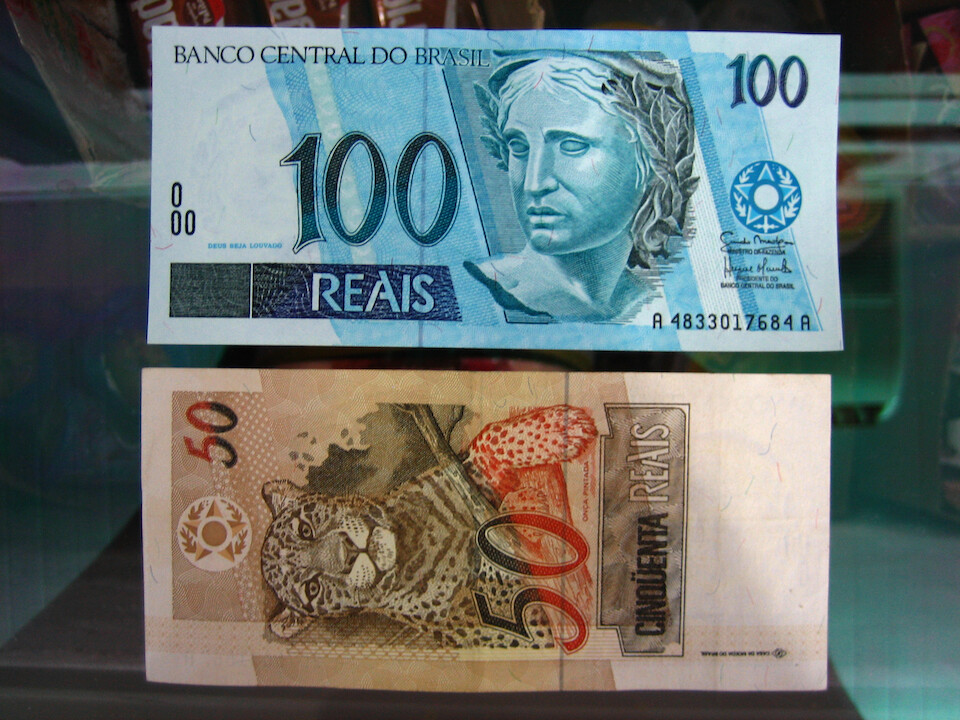 The Brazilian currency is the Real (pronounced 'hey-ai'). USD $1 = R$ 1.70. R$ 100 = $58. It's a beautifully designed currency and the first one that I've seen with a portrait print on the backside of the notes. The portraits are of the various animals found in this biologically rich land. This currency was introduced in 1994 to end decades of hyperinflation in Brazil, which was also timed nicely with Brazil's rise in economic power.
The Brazilian currency is the Real (pronounced 'hey-ai'). USD $1 = R$ 1.70. R$ 100 = $58. It's a beautifully designed currency and the first one that I've seen with a portrait print on the backside of the notes. The portraits are of the various animals found in this biologically rich land. This currency was introduced in 1994 to end decades of hyperinflation in Brazil, which was also timed nicely with Brazil's rise in economic power.
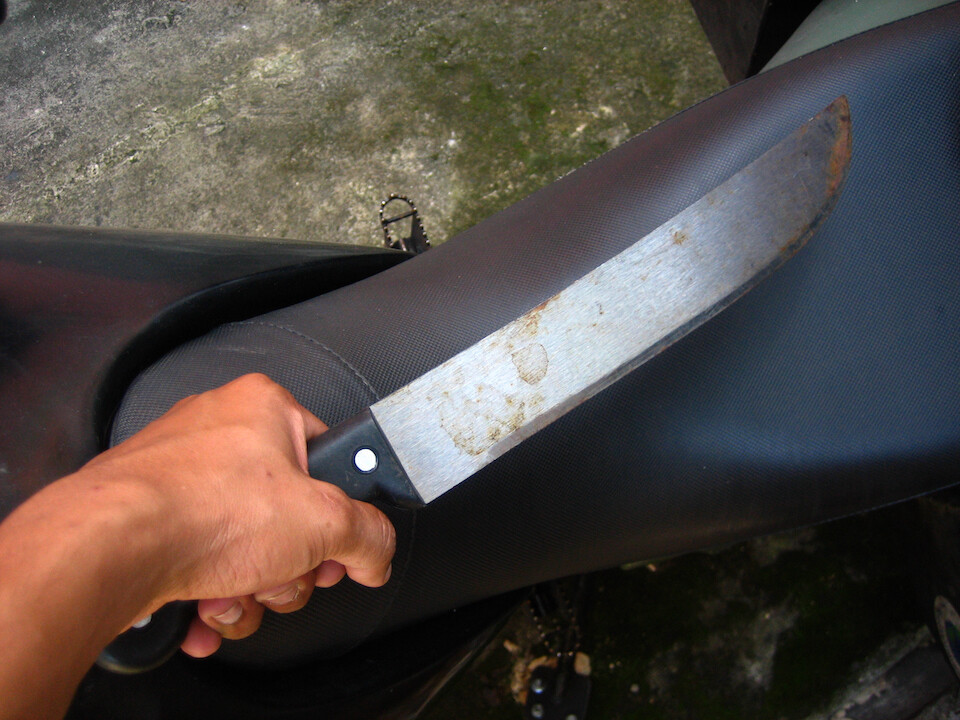 Since I was going to be camping in the wild a lot more now, I figured I needed some sort of protection at night in case I was approached by would be bandits or jaguars. It's the snakes I was really afraid of, so I bought this machete in La Paz for USD 3. In Portuguese, a knife is called a 'faca' and a big knife is called a 'facão', pronounced 'fackauwn' - sounds deadly just saying it. When tenting it, I slept with the facão by my side with my hand ready on it. I covered it in a sweatshirt until it would be called upon. Just hope the police don't find it during a regular search; would be hard to explain but I'm going to try saying I need it as a meat cleaver, being a cook and all. Throw me a chicken and it'll be diced up in 5 minutes.
Since I was going to be camping in the wild a lot more now, I figured I needed some sort of protection at night in case I was approached by would be bandits or jaguars. It's the snakes I was really afraid of, so I bought this machete in La Paz for USD 3. In Portuguese, a knife is called a 'faca' and a big knife is called a 'facão', pronounced 'fackauwn' - sounds deadly just saying it. When tenting it, I slept with the facão by my side with my hand ready on it. I covered it in a sweatshirt until it would be called upon. Just hope the police don't find it during a regular search; would be hard to explain but I'm going to try saying I need it as a meat cleaver, being a cook and all. Throw me a chicken and it'll be diced up in 5 minutes.
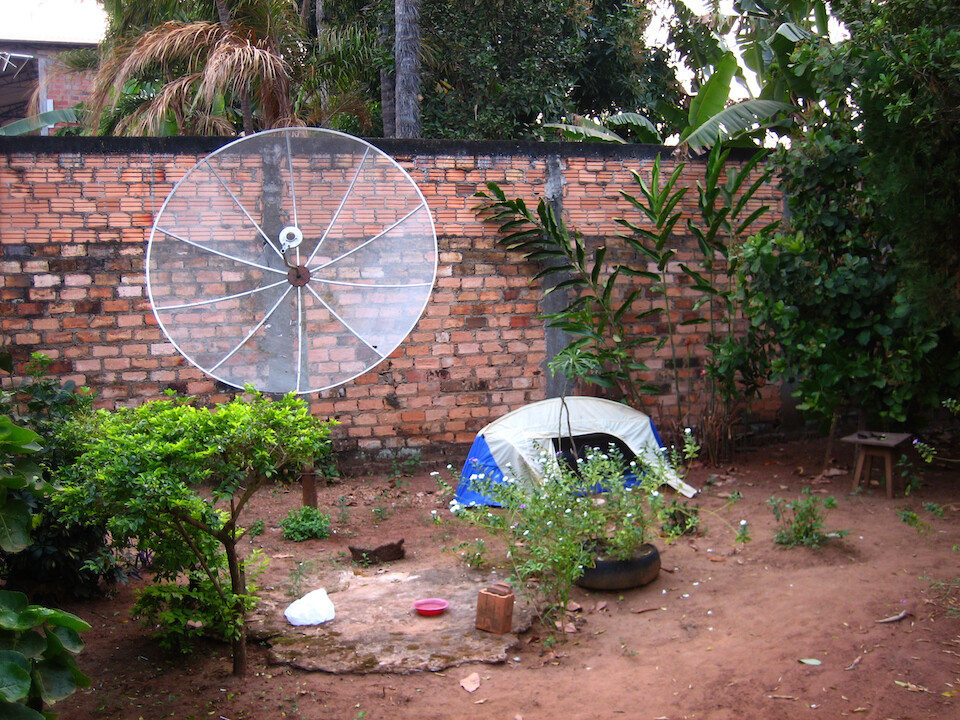 I got released from customs around 6 pm and since it was dark already, I stopped at the first hotel. But they were all booked out for a festival and not having the energy to go scouring the town for another hotel, I asked them if I could just camp out back in the garden. Sure, no problem and they even said I didn't have to pay but could still take a shower and use the facilities. I was starting to accept that all Brazilians were really nice and warm. There was also ice-cold water for the taking and I gulped down as much as I could before setting out the next morning (resulting in frequent pee stops). I tried tapping into the satellite dish to get the results of the latest Formula 1 race, but no dice.
I got released from customs around 6 pm and since it was dark already, I stopped at the first hotel. But they were all booked out for a festival and not having the energy to go scouring the town for another hotel, I asked them if I could just camp out back in the garden. Sure, no problem and they even said I didn't have to pay but could still take a shower and use the facilities. I was starting to accept that all Brazilians were really nice and warm. There was also ice-cold water for the taking and I gulped down as much as I could before setting out the next morning (resulting in frequent pee stops). I tried tapping into the satellite dish to get the results of the latest Formula 1 race, but no dice.
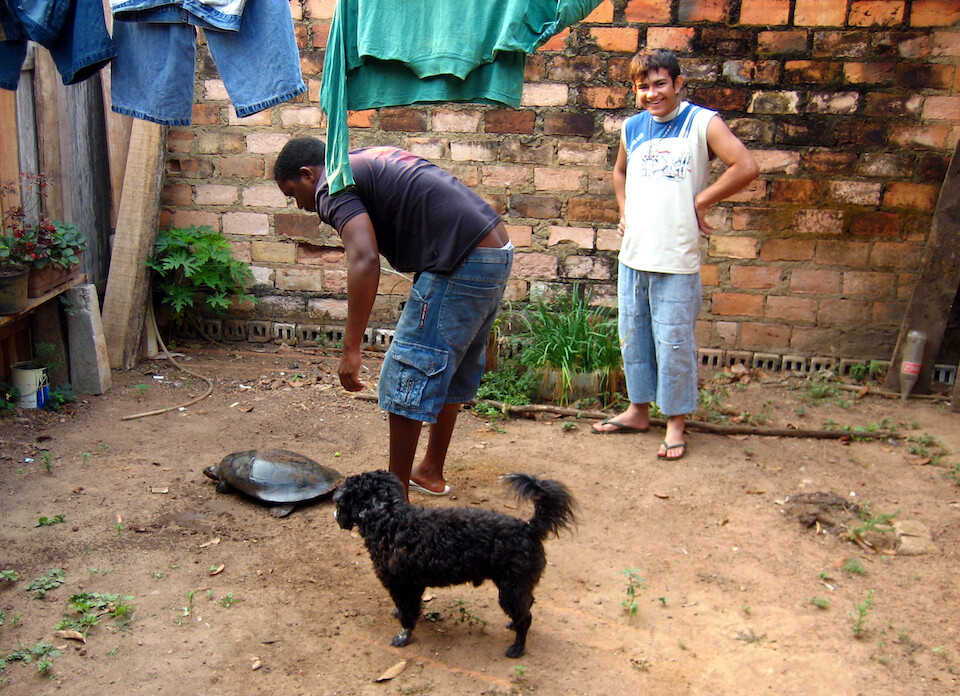 The next morning, the family running the pousada (small hotel) was getting ready for a feast and this river turtle's throat was slit and laid to die so that it's meat could be cooked and enjoyed. They kept the turtle fresh in a small bucket of water until it was to meet its destiny. When I was young in Zambia, I wanted to go see a goat being killed for a party that we were throwing, but my father warned me that it would affect my taste for meat. It still has the same effect and perhaps everyone should be obliged to see how their food is killed before it appears on the dinner plate.
The next morning, the family running the pousada (small hotel) was getting ready for a feast and this river turtle's throat was slit and laid to die so that it's meat could be cooked and enjoyed. They kept the turtle fresh in a small bucket of water until it was to meet its destiny. When I was young in Zambia, I wanted to go see a goat being killed for a party that we were throwing, but my father warned me that it would affect my taste for meat. It still has the same effect and perhaps everyone should be obliged to see how their food is killed before it appears on the dinner plate.
 Heading out of Guajara-mirim on 530 kms (330 mi) of asphalt through Porto Velho and onto Humaita, the start of the fabled roads through the Amazon.
Heading out of Guajara-mirim on 530 kms (330 mi) of asphalt through Porto Velho and onto Humaita, the start of the fabled roads through the Amazon.
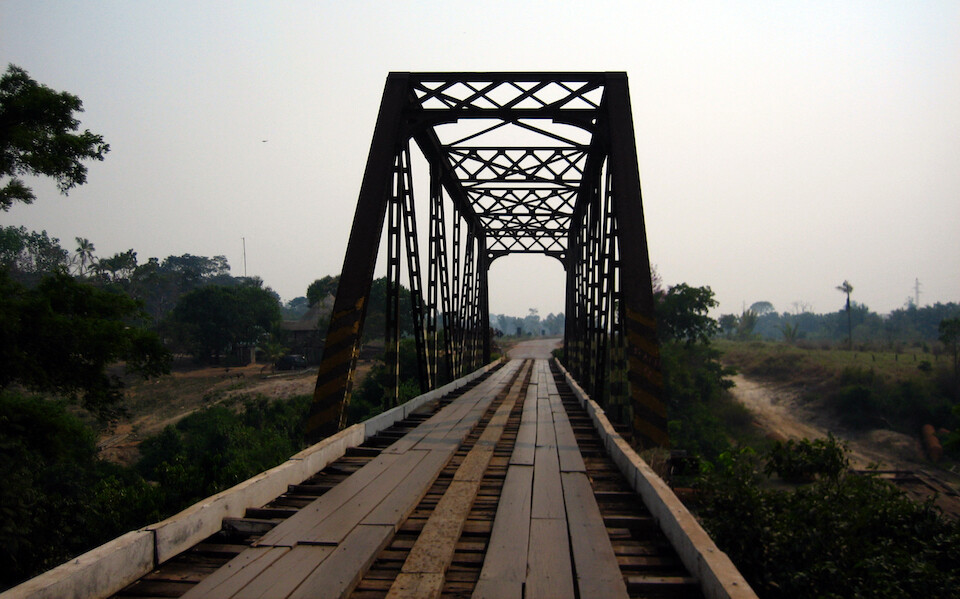 Crossing a wooden bridge; a taste for things to come.
Crossing a wooden bridge; a taste for things to come.
 Distance board on highway BR-364 heading to Porto Velho, an example of the well-signed roads here.
Distance board on highway BR-364 heading to Porto Velho, an example of the well-signed roads here.
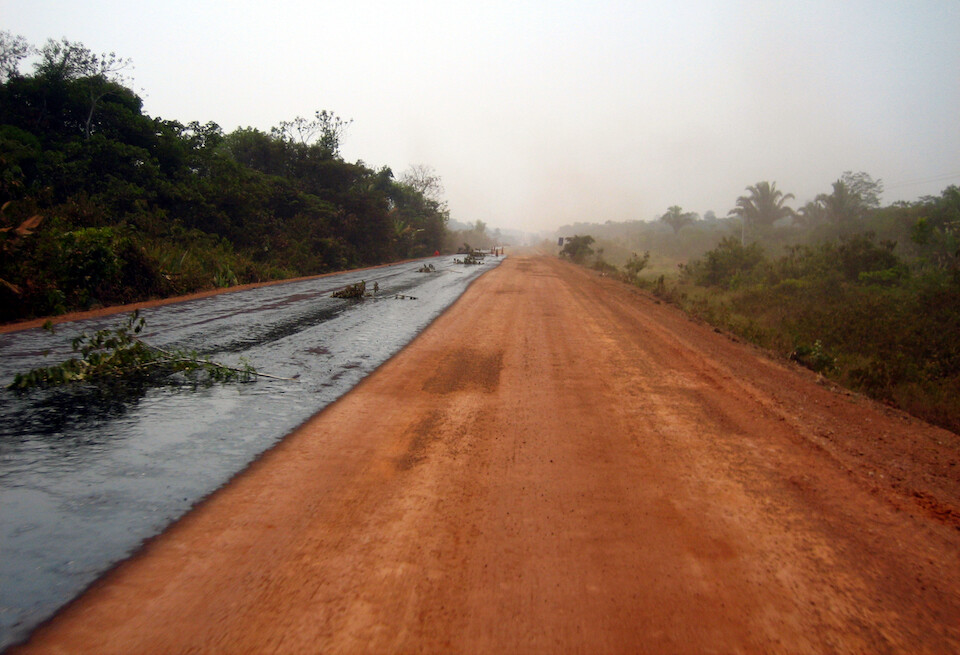 The road was being paved in areas, but overall, the riding was smooth allowing me to cover lots of ground.
The road was being paved in areas, but overall, the riding was smooth allowing me to cover lots of ground.
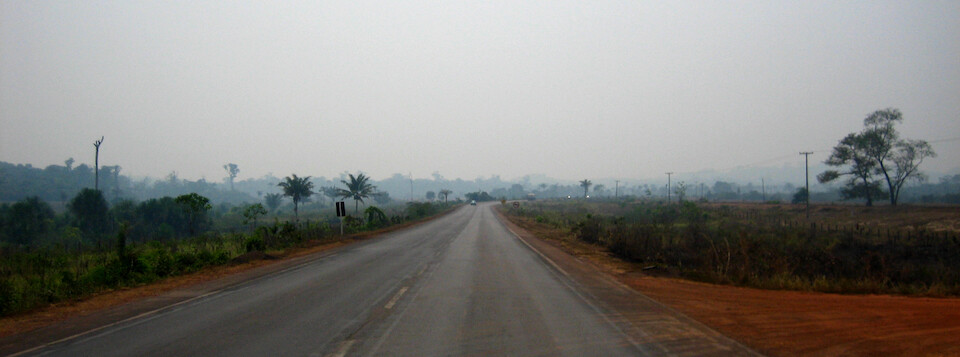 Smoky haze, a sad but true reality of development in the Amazon.
Smoky haze, a sad but true reality of development in the Amazon.
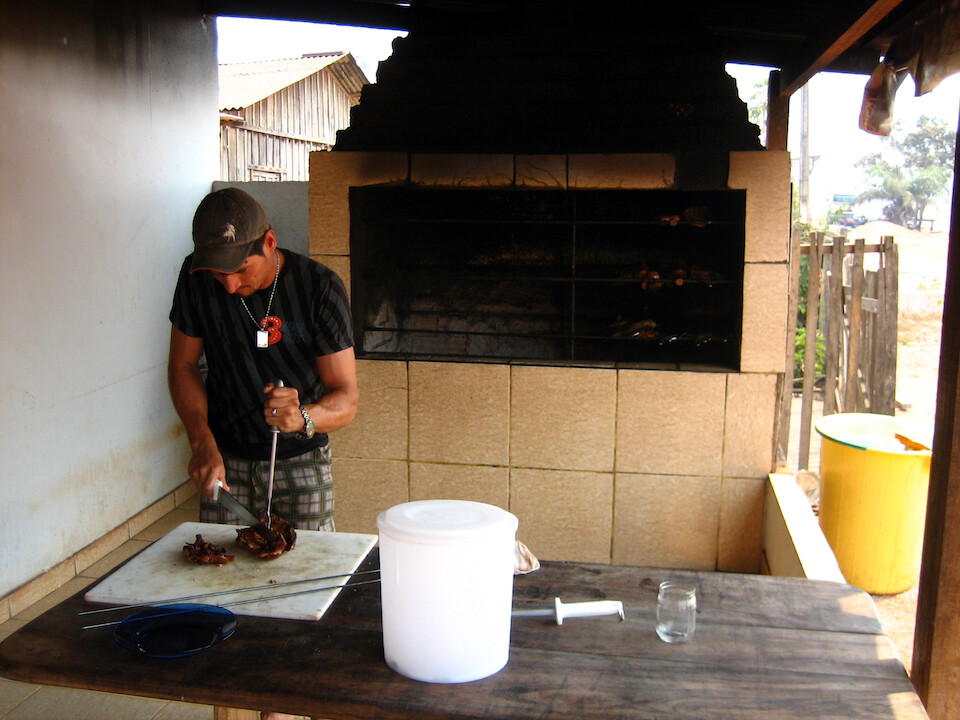 Knowing I would be frugal with my food expenses from here on and celebrating my first day here, I treated myself to a RUSD 10 Brazilian Churrasco (barbeque) for lunch. These type of restaurants are available all across Brazil and are considered the typical road food.
Knowing I would be frugal with my food expenses from here on and celebrating my first day here, I treated myself to a RUSD 10 Brazilian Churrasco (barbeque) for lunch. These type of restaurants are available all across Brazil and are considered the typical road food.
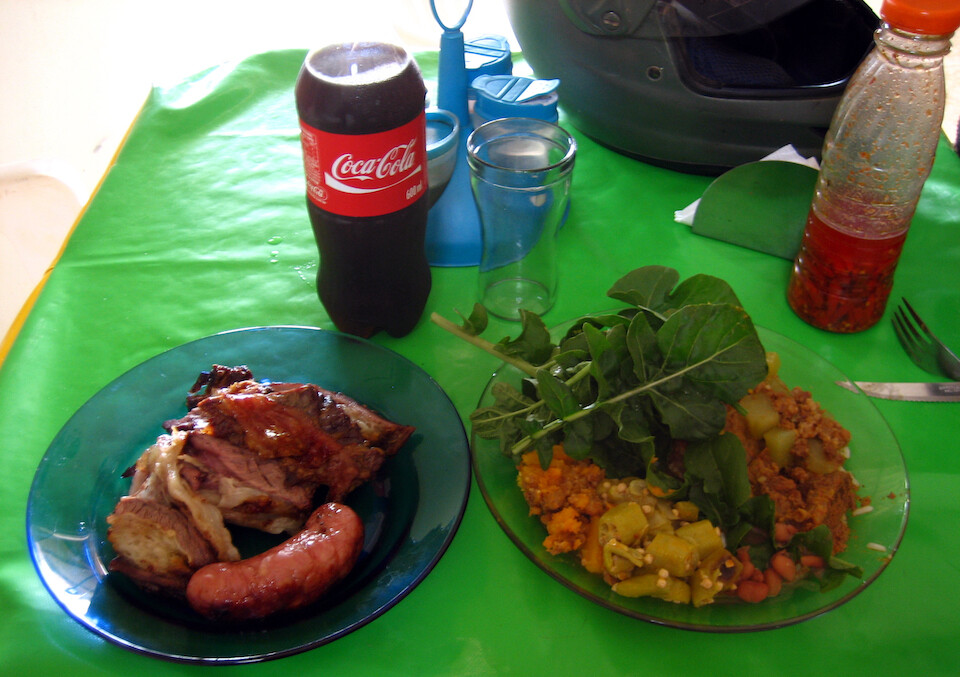 I had two plates of meat cuts (sausage, ribs, roast beef, chicken) along with plates from the buffet line that had a good selection of salads and veggies. Brazilian food in general isn't spicy like all other South American countries, but all tables come with a local hot sauce; here it was chillies preserved in oil, which went well with the meats. Primarily drinking water (from my filter), I also treated myself to a RUSD 2 Coke, which was great for washing down all the grease. This meal was blowing my food budget, but I learned from Holger and Anja (RTW riders from Germany) that even though you need to keep a tight budget to do a trip like this, you should treat yourself once in a while if you're in this for the long haul.
I had two plates of meat cuts (sausage, ribs, roast beef, chicken) along with plates from the buffet line that had a good selection of salads and veggies. Brazilian food in general isn't spicy like all other South American countries, but all tables come with a local hot sauce; here it was chillies preserved in oil, which went well with the meats. Primarily drinking water (from my filter), I also treated myself to a RUSD 2 Coke, which was great for washing down all the grease. This meal was blowing my food budget, but I learned from Holger and Anja (RTW riders from Germany) that even though you need to keep a tight budget to do a trip like this, you should treat yourself once in a while if you're in this for the long haul.
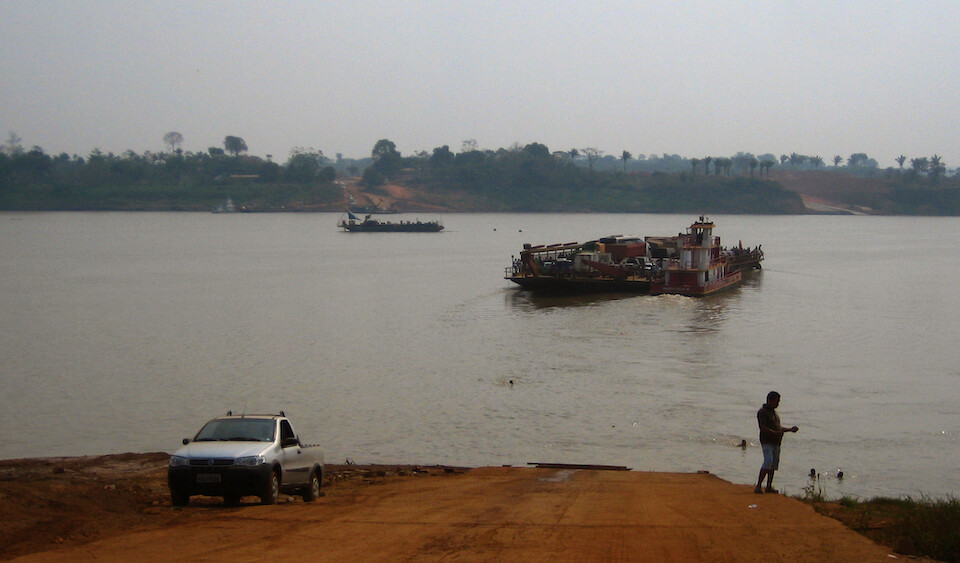 Catching the first of many ferries across the numerous rivers of the expansive Amazon River basin just outside Porto Velho. This is Rio Madeira, the biggest tributary of the Amazon River, which is further north.
Catching the first of many ferries across the numerous rivers of the expansive Amazon River basin just outside Porto Velho. This is Rio Madeira, the biggest tributary of the Amazon River, which is further north.
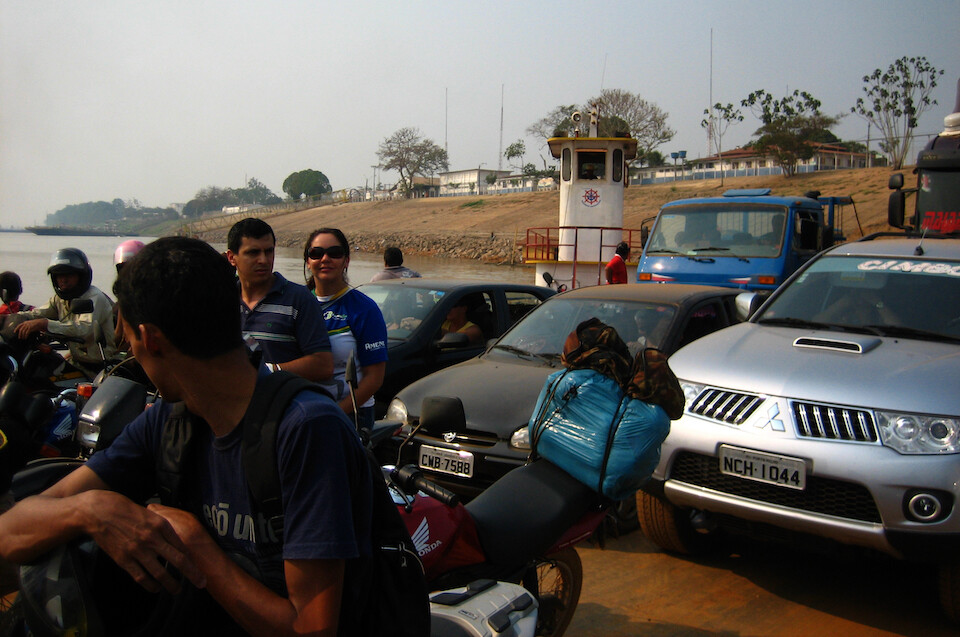 Locals working in Porto Velho, the biggest city in the area, returning to homes on the other side of the river. An elderly rider was very impressed with the sight of my bike and invited me to stay on his farm (fazenda) a few kilometers on the other side, but I had more ground to cover.
Locals working in Porto Velho, the biggest city in the area, returning to homes on the other side of the river. An elderly rider was very impressed with the sight of my bike and invited me to stay on his farm (fazenda) a few kilometers on the other side, but I had more ground to cover.
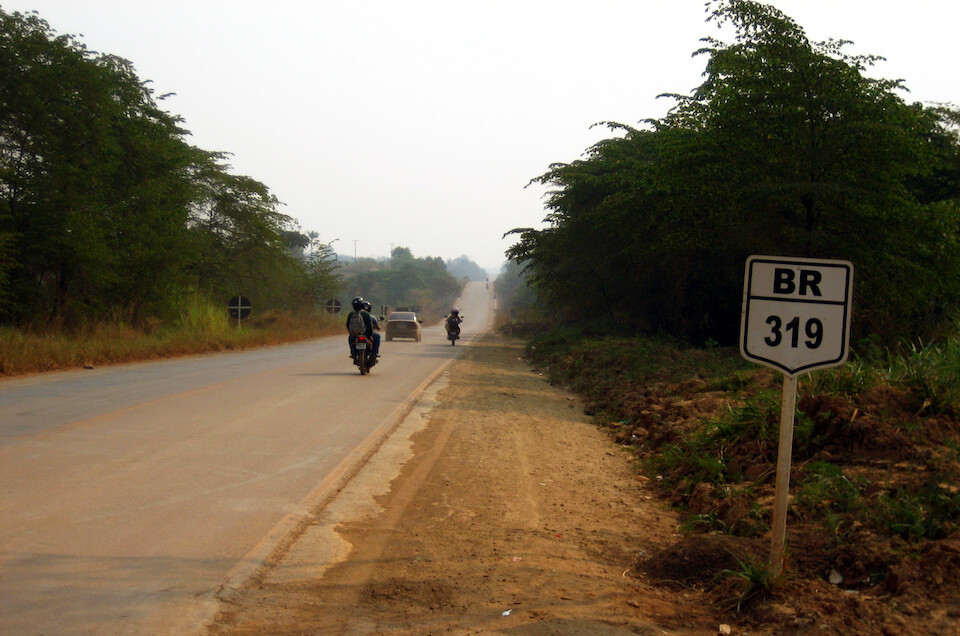 Riding BR-319 towards Humaita, where the pavement stops. This is one of the two major roads crossing the Amazon and heads north to Manaus on the Amazon River from Humaita. The road is notorious in the rainy season and a call to riders in the dry season, which is now, from July to September. From Humaita, I would be taking BR-230, the TransAmazonica Highway, which parallels the Amazon River a few hundred kilometers inland.
Riding BR-319 towards Humaita, where the pavement stops. This is one of the two major roads crossing the Amazon and heads north to Manaus on the Amazon River from Humaita. The road is notorious in the rainy season and a call to riders in the dry season, which is now, from July to September. From Humaita, I would be taking BR-230, the TransAmazonica Highway, which parallels the Amazon River a few hundred kilometers inland.
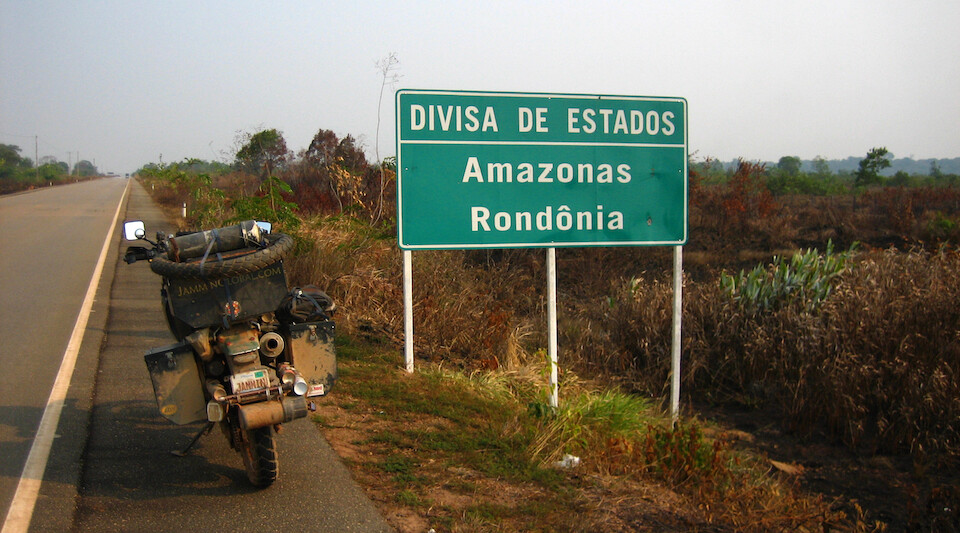 At the state border between Rondonia and the great Amazonas state.
At the state border between Rondonia and the great Amazonas state.
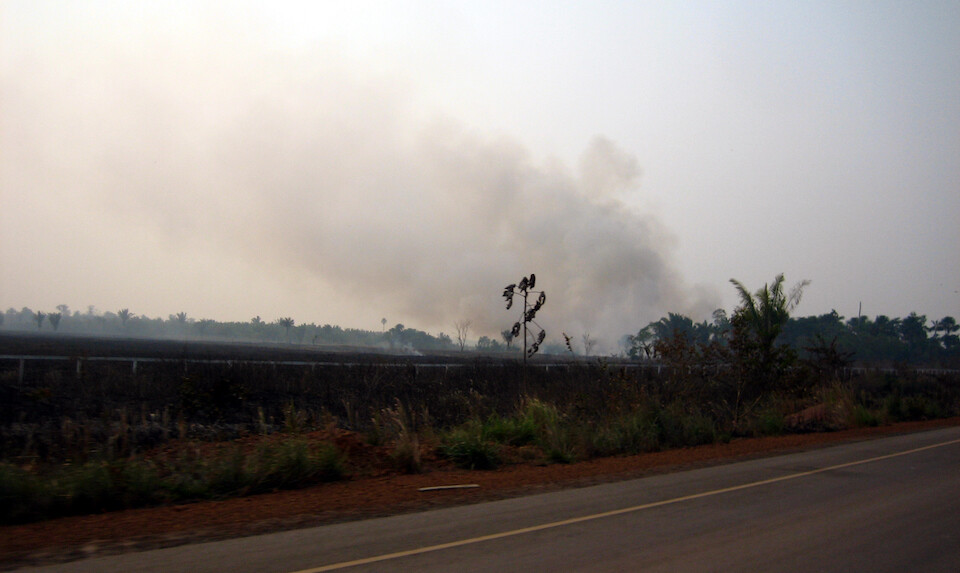 More biomass burning for agriculture.
More biomass burning for agriculture.
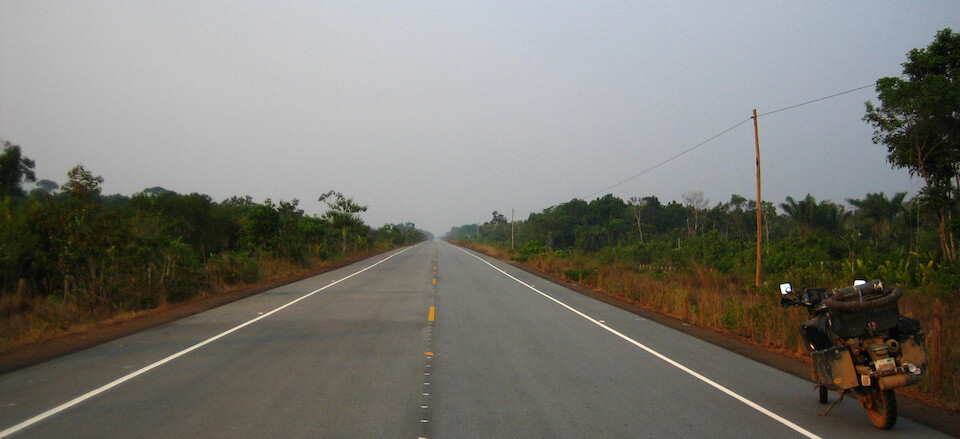 The well-maintained section of BR-319 heading north to Humaita.
The well-maintained section of BR-319 heading north to Humaita.
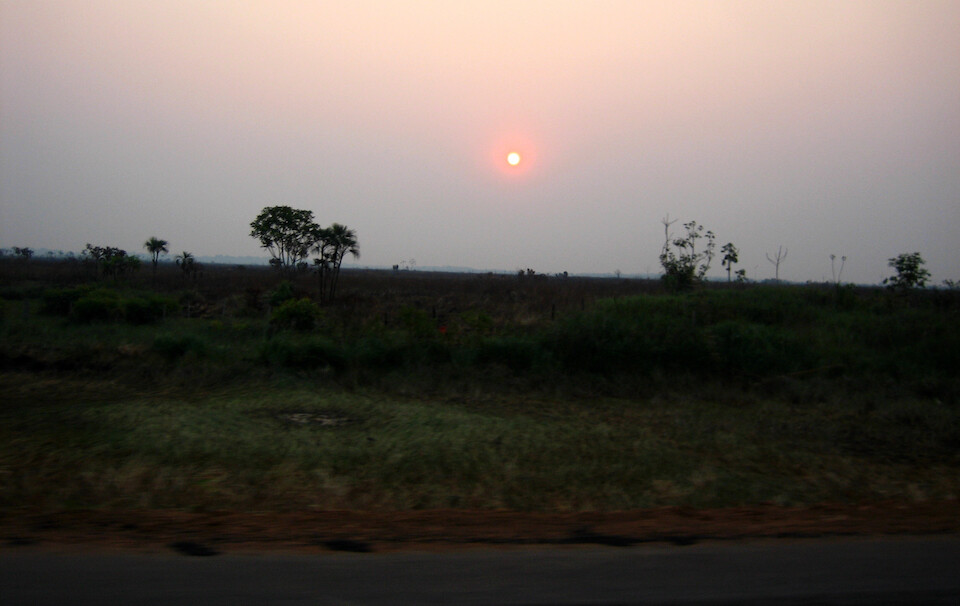 The sun setting on my first day of riding in Brazil and I covered a huge amount in comparison to my daily average, doing 530 kms (330 mi). Due to the smoke haze in the air, the sunsets here were similar to those induced by the dust haze in the Bolivian pampas, allowing for the whole sun to be seen for a long time before it finally set.
The sun setting on my first day of riding in Brazil and I covered a huge amount in comparison to my daily average, doing 530 kms (330 mi). Due to the smoke haze in the air, the sunsets here were similar to those induced by the dust haze in the Bolivian pampas, allowing for the whole sun to be seen for a long time before it finally set.
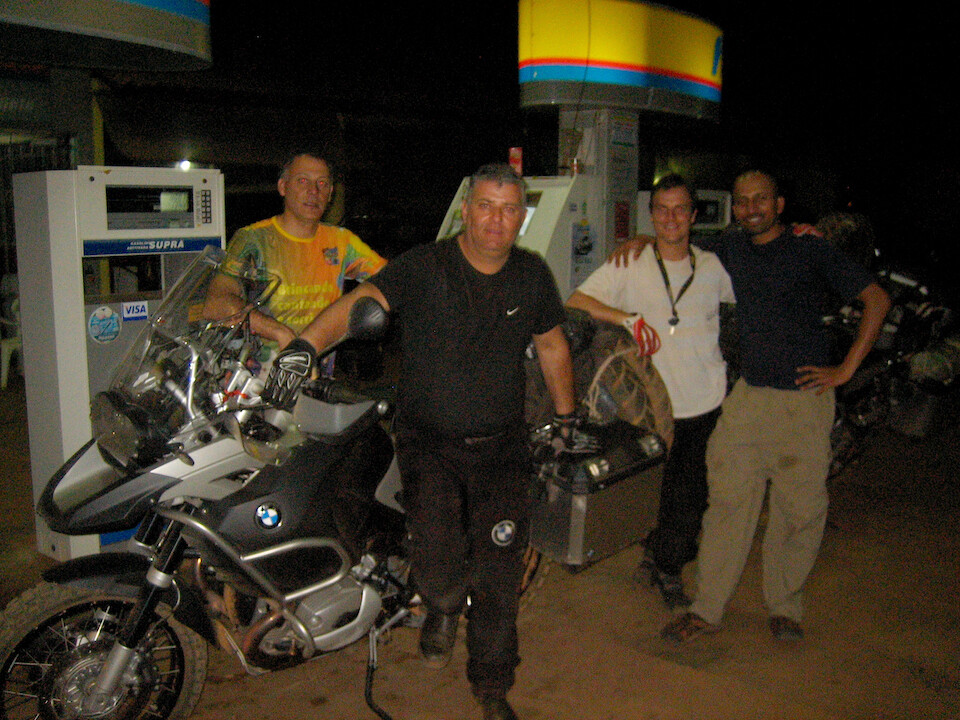 At the gas station in Humaita, I met up with these three Argentinian riders from Cordoba on big BMW R1200GS's. They passed me in the Bolivian pampas as I was setting up camp one night and I got ahead of them today. They were making a loop through Bolivia, up BR-319 to Manaus, over into Venezuela and down the Andes back home over two months. They invited me to visit when I got to Argentina.
At the gas station in Humaita, I met up with these three Argentinian riders from Cordoba on big BMW R1200GS's. They passed me in the Bolivian pampas as I was setting up camp one night and I got ahead of them today. They were making a loop through Bolivia, up BR-319 to Manaus, over into Venezuela and down the Andes back home over two months. They invited me to visit when I got to Argentina.
 Preparing for the grand expedition that lay ahead, the crossing of the Rodovia Transamazônica, I was rightly in expedition mode, camping and providing my own food. The nice thing in Brazil is that you can camp at the petrol stations for free and they provide showers and ice-cold drinking water (meant for the truckers). Along with gasoline, that's all I need. Plus, since most stations are open 24 hours, it adds a sense of security if the attendants can keep an eye on my camp. My strategy while camping is to put the bike and tent as close as possible, put my jacket under my legs in the tent since my air mattress is only for the torso, put my riding pants, boots and helmet on the bike seat and cover it all with the bike cover. I then run a simple cable lock between those items, the bike cover and a tent peg, so that if someone tried to touch the bike during the night, it would rattle the tent and I would be ready with my facão.
Preparing for the grand expedition that lay ahead, the crossing of the Rodovia Transamazônica, I was rightly in expedition mode, camping and providing my own food. The nice thing in Brazil is that you can camp at the petrol stations for free and they provide showers and ice-cold drinking water (meant for the truckers). Along with gasoline, that's all I need. Plus, since most stations are open 24 hours, it adds a sense of security if the attendants can keep an eye on my camp. My strategy while camping is to put the bike and tent as close as possible, put my jacket under my legs in the tent since my air mattress is only for the torso, put my riding pants, boots and helmet on the bike seat and cover it all with the bike cover. I then run a simple cable lock between those items, the bike cover and a tent peg, so that if someone tried to touch the bike during the night, it would rattle the tent and I would be ready with my facão.
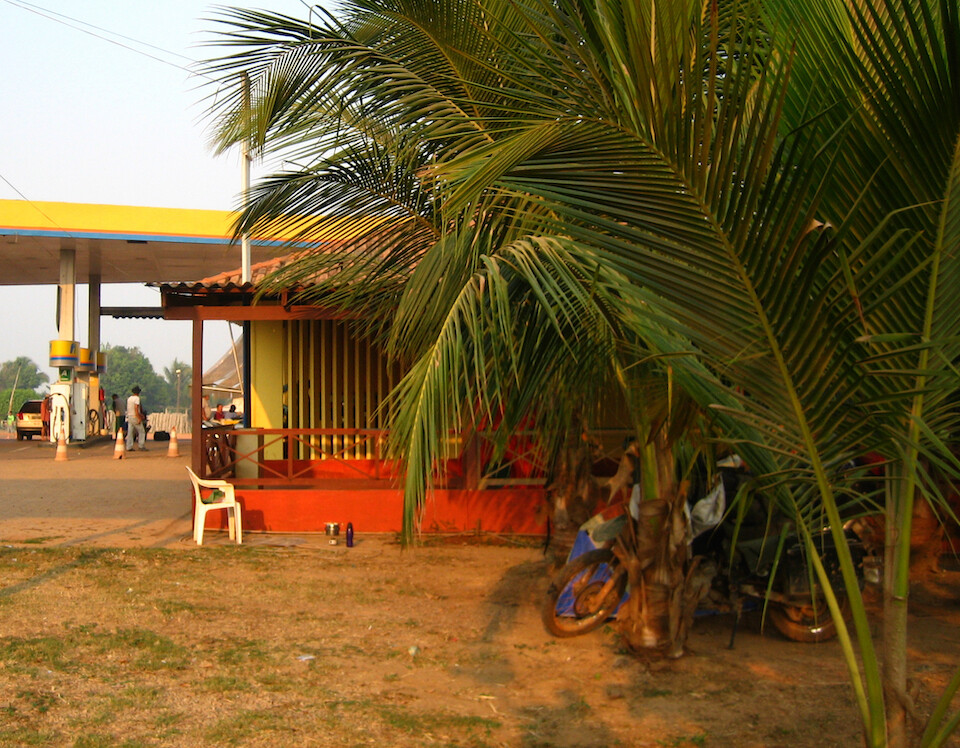 Just to give a sense of location; I was camping to the side of this gas station in Humaita. The attendants told me to camp in a place where they could see me for my safety, but I also didn't want to camp right in the open, inviting a possible incident.
Just to give a sense of location; I was camping to the side of this gas station in Humaita. The attendants told me to camp in a place where they could see me for my safety, but I also didn't want to camp right in the open, inviting a possible incident.
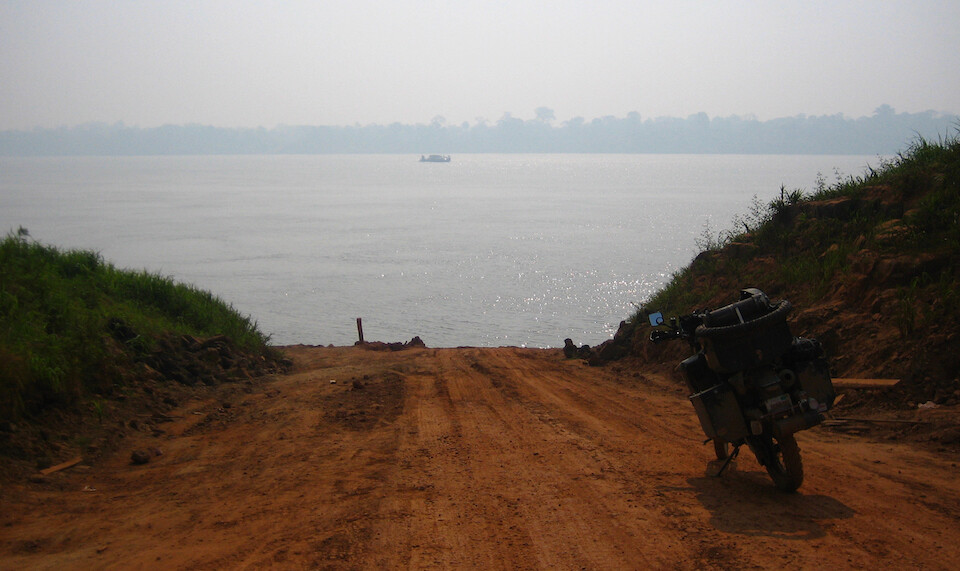 Waiting for the ferry the next morning to cross back over the Rio Madeira. This river runs for about 3,250 km (2,020 mi) before emptying into the Amazon River just past Manaus. It's considered the biggest tributary in the world and rises a staggering 15 m (50 ft) in the rainy season allowing ocean-going vessels to sail up to Porto Velho, 1,070 km (663 mi) from its mouth.
Waiting for the ferry the next morning to cross back over the Rio Madeira. This river runs for about 3,250 km (2,020 mi) before emptying into the Amazon River just past Manaus. It's considered the biggest tributary in the world and rises a staggering 15 m (50 ft) in the rainy season allowing ocean-going vessels to sail up to Porto Velho, 1,070 km (663 mi) from its mouth.
 There's reasonable truck traffic on this route. This double trailer (standard issue in Brazil) had to be off loaded one trailer at a time due to the steep angle and sandy approach at the bank.
There's reasonable truck traffic on this route. This double trailer (standard issue in Brazil) had to be off loaded one trailer at a time due to the steep angle and sandy approach at the bank.
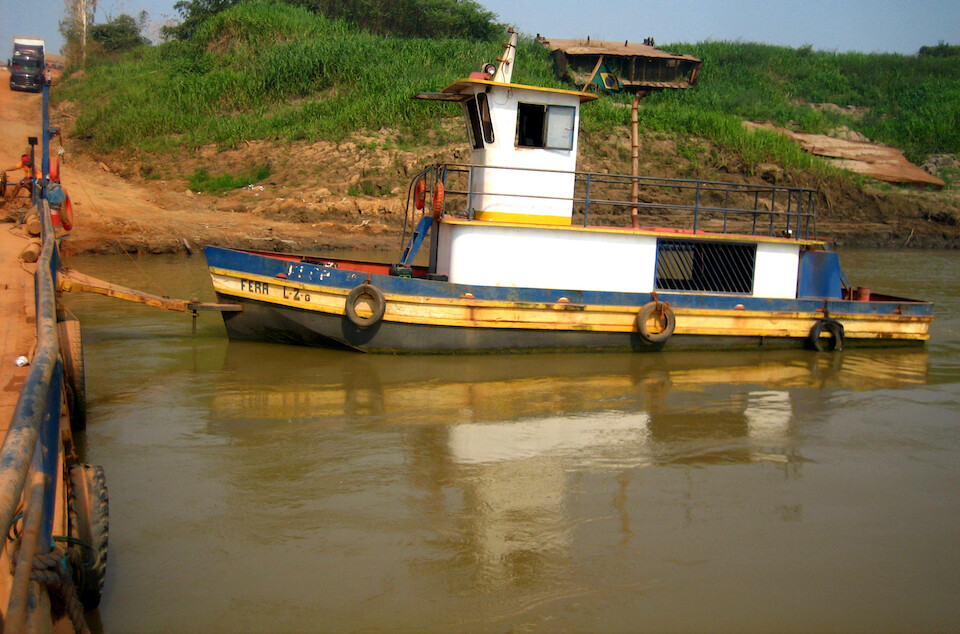 The ferries themselves are unpowered. Their locomotion comes from a tug boat attached to the side, which is handy for maneuvering the ferry and changing directions.
The ferries themselves are unpowered. Their locomotion comes from a tug boat attached to the side, which is handy for maneuvering the ferry and changing directions.
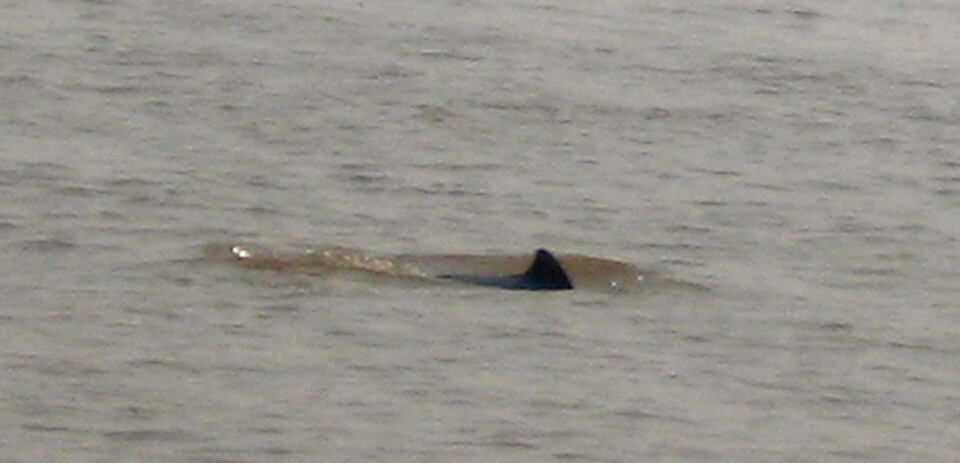 Trying to get a shot of a Boto, the Amazon Pink River Dolphin, which is revered by the local tribes and has been put into legends of coition between humans and dolphins.
Trying to get a shot of a Boto, the Amazon Pink River Dolphin, which is revered by the local tribes and has been put into legends of coition between humans and dolphins.
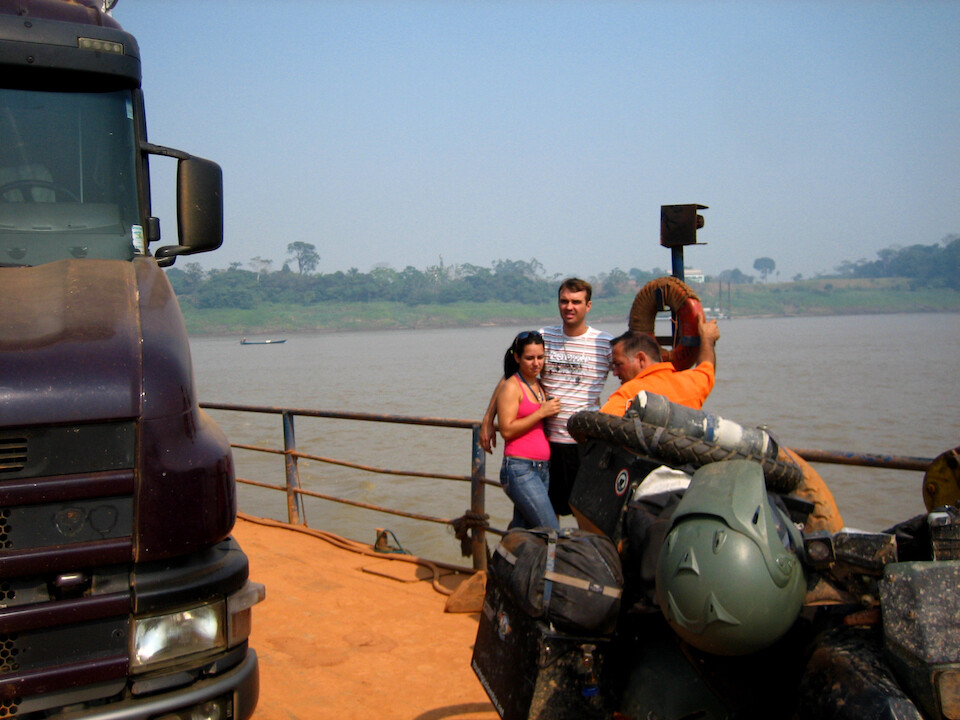 I passed this trucking couple yesterday and we stayed at the same gas station last night. They're from the southern state of Santa Catarina and are heading along the TransAmazonica up to Apui to pick up a load of timber. It was impressive to see his wife maneuvering the rig onto the ferry as he directed her.
I passed this trucking couple yesterday and we stayed at the same gas station last night. They're from the southern state of Santa Catarina and are heading along the TransAmazonica up to Apui to pick up a load of timber. It was impressive to see his wife maneuvering the rig onto the ferry as he directed her.
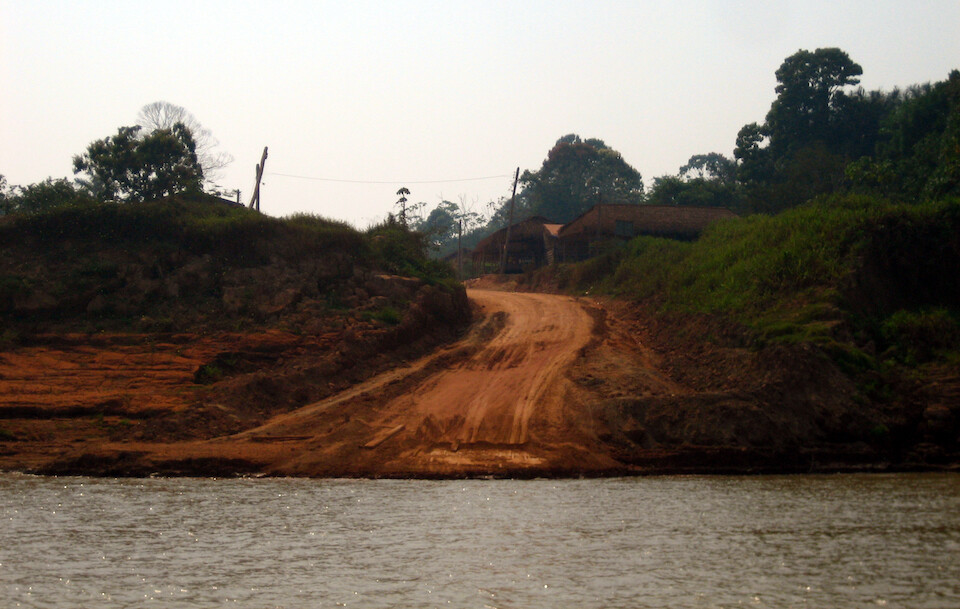 My clutch was not excited at the thought of all these sandy banks that lay ahead. I tightened the clutch cable to get better engagement and I hoped it would last till Sao Luis. I had one more spare KLX disc if things got worse.
My clutch was not excited at the thought of all these sandy banks that lay ahead. I tightened the clutch cable to get better engagement and I hoped it would last till Sao Luis. I had one more spare KLX disc if things got worse.
 Woo hoo! The off-road start of BR-230, the TransAmazonica Highway. Ahead lies 2,070 kms (1,285 mi) of dirt roads to Maraba and I did about 200 kms (125 mi) a day.
Woo hoo! The off-road start of BR-230, the TransAmazonica Highway. Ahead lies 2,070 kms (1,285 mi) of dirt roads to Maraba and I did about 200 kms (125 mi) a day.
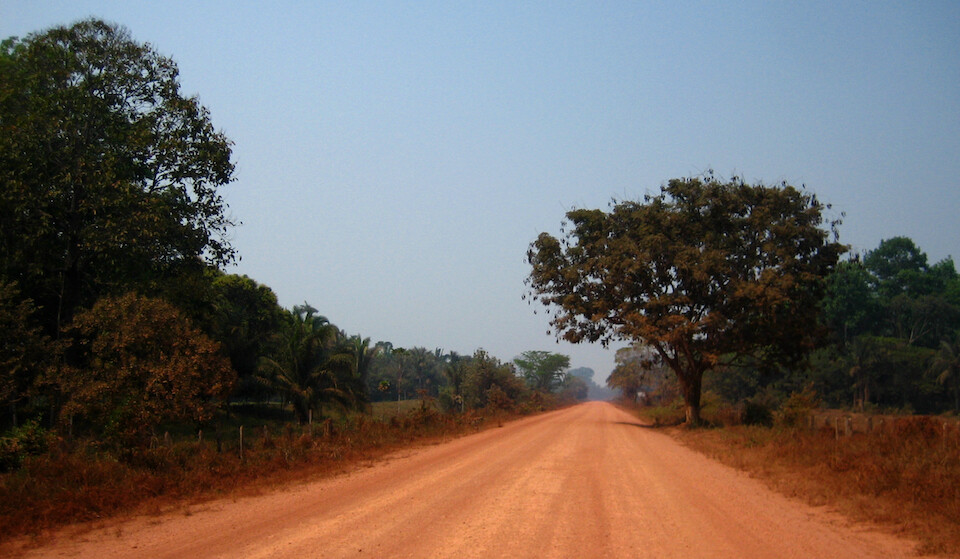 It was built in the 1970s when Brazil was ruled by military dictatorships who completed a series of grand construction projects. This highway was intended to link the remote northern parts with the rest of the country. It's initial design was to run all the way to Peru and Ecuador but that didn't happen. It was also originally designed to be paved all the way, but that too, thankfully, hasn't materialized along its entire length. The pavement starts again once it reaches civilization in Maraba.
It was built in the 1970s when Brazil was ruled by military dictatorships who completed a series of grand construction projects. This highway was intended to link the remote northern parts with the rest of the country. It's initial design was to run all the way to Peru and Ecuador but that didn't happen. It was also originally designed to be paved all the way, but that too, thankfully, hasn't materialized along its entire length. The pavement starts again once it reaches civilization in Maraba.
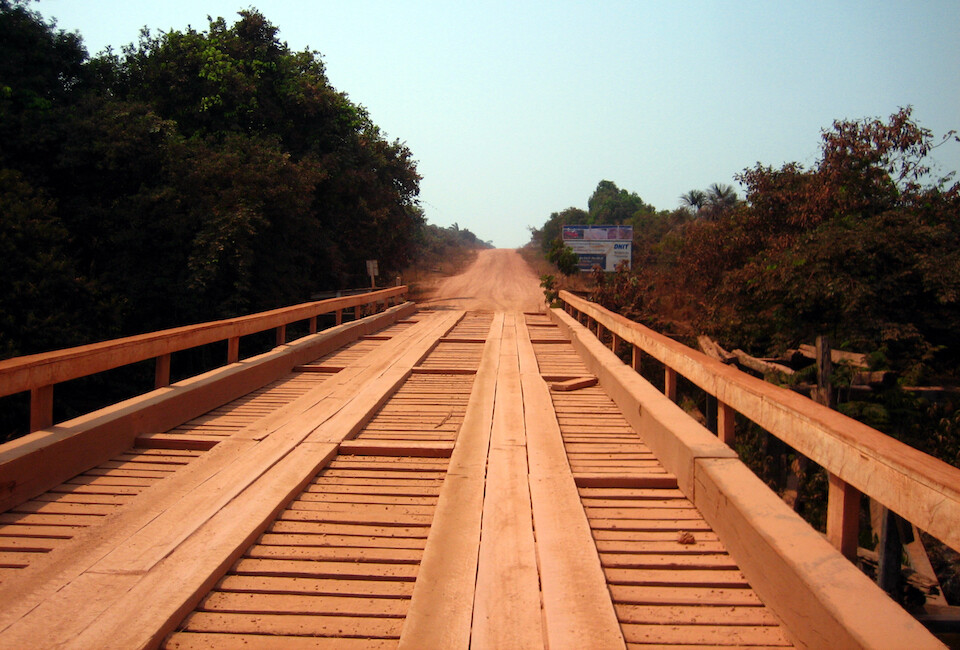 The TransAmazonica is famous for its numerous wooden bridges and I was happy to see a well-maintained one for my first crossing.
The TransAmazonica is famous for its numerous wooden bridges and I was happy to see a well-maintained one for my first crossing.
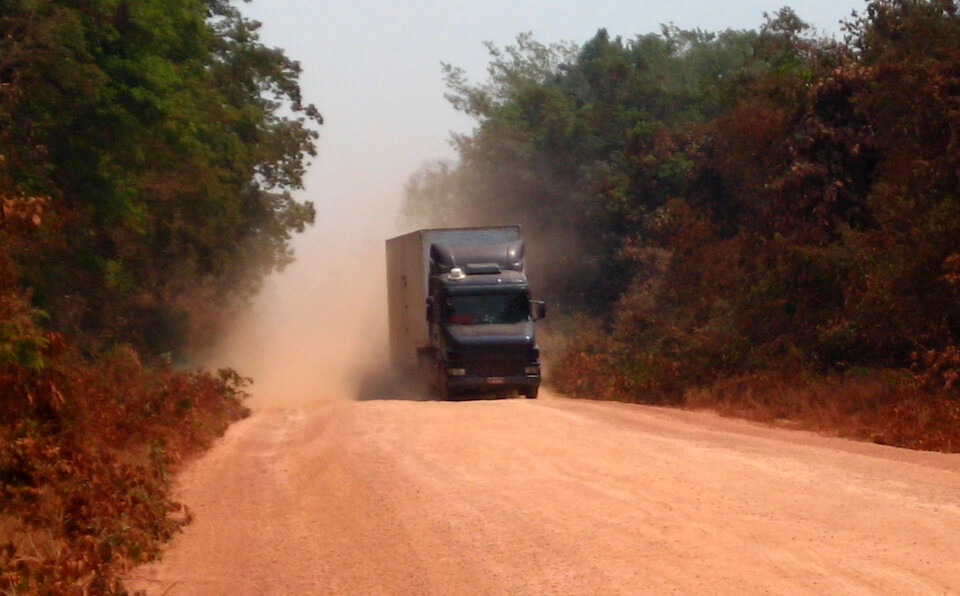 It's advisable to traverse the TransAmazonica only during the driest months (July to September) as when it rains, the road turns to a sloppy mud halting almost all traffic in their tracks. But, being here during the dry season means lots and lots of dust. I was already accustomed to the dust by now having crossed the dry Bolivian pampas and told myself, no complaining, just take a deep breath as a dust cloud approaches and get on with it. I was happy to see my trucking friends again, but not so thrilled for their dust wake. The road is generally well-maintained but there're a lot of dips and bumps and I was moving on average as fast or slow as the big rigs. You can imagine what overtaking one of these guys must be like - try and get a glimpse of the road ahead and then ride blind trough the dust cloud, hoping there's no oncoming traffic.
It's advisable to traverse the TransAmazonica only during the driest months (July to September) as when it rains, the road turns to a sloppy mud halting almost all traffic in their tracks. But, being here during the dry season means lots and lots of dust. I was already accustomed to the dust by now having crossed the dry Bolivian pampas and told myself, no complaining, just take a deep breath as a dust cloud approaches and get on with it. I was happy to see my trucking friends again, but not so thrilled for their dust wake. The road is generally well-maintained but there're a lot of dips and bumps and I was moving on average as fast or slow as the big rigs. You can imagine what overtaking one of these guys must be like - try and get a glimpse of the road ahead and then ride blind trough the dust cloud, hoping there's no oncoming traffic.
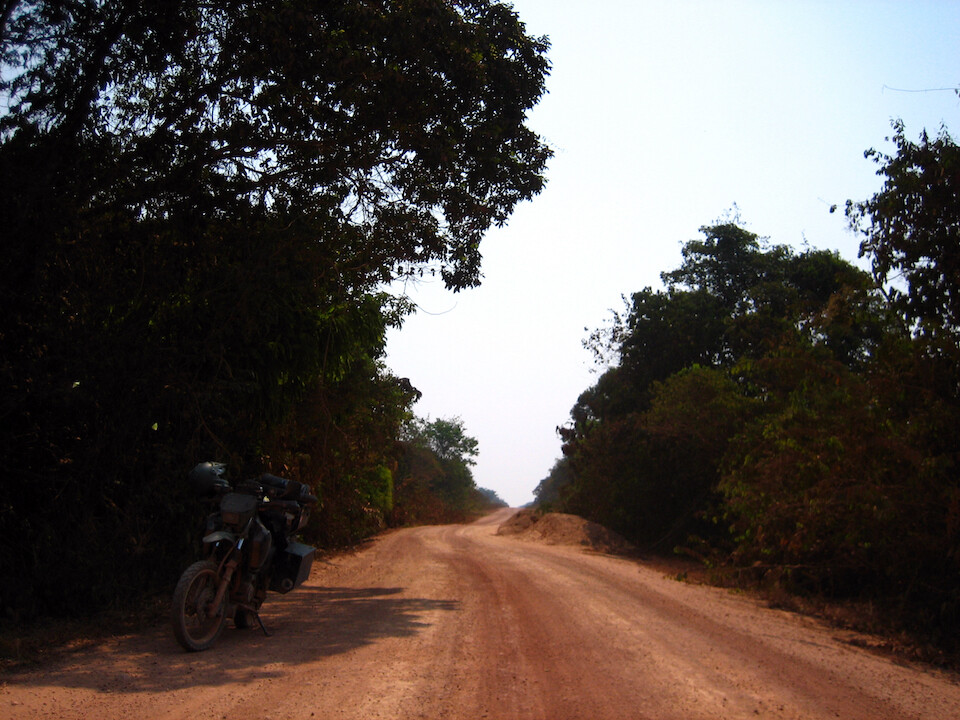 It was hot and there wasn't much shade around. Taking a break in the shadows, munching on some nuts and prunes and keeping hydrated. I only saw a handful of vehicles all day.
It was hot and there wasn't much shade around. Taking a break in the shadows, munching on some nuts and prunes and keeping hydrated. I only saw a handful of vehicles all day.
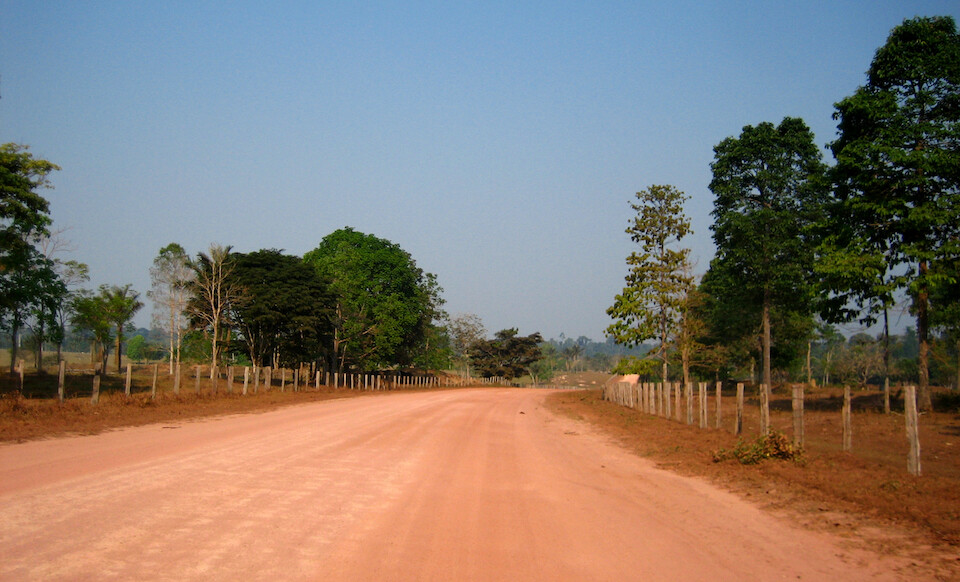 The sad reality of the TransAmazonica is that deforestation of the Amazon jungle is prevalent all along the route and the government encouraged this behavior, giving incentives for farmers and cattle ranchers to turn highly valuable intact forests into single-purpose pasture land to feed Brazil's domestic and export beef addiction. Farms (fazendas) line the TransAmazonica almost all along its entire length.
The sad reality of the TransAmazonica is that deforestation of the Amazon jungle is prevalent all along the route and the government encouraged this behavior, giving incentives for farmers and cattle ranchers to turn highly valuable intact forests into single-purpose pasture land to feed Brazil's domestic and export beef addiction. Farms (fazendas) line the TransAmazonica almost all along its entire length.
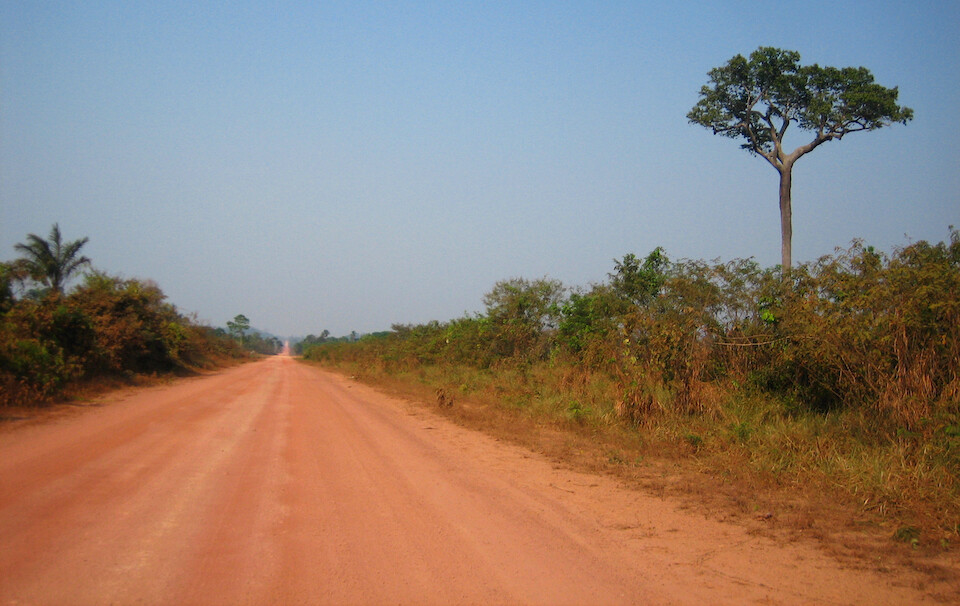 The flora in the western end is mainly shrubs with a few tall trees.
The flora in the western end is mainly shrubs with a few tall trees.
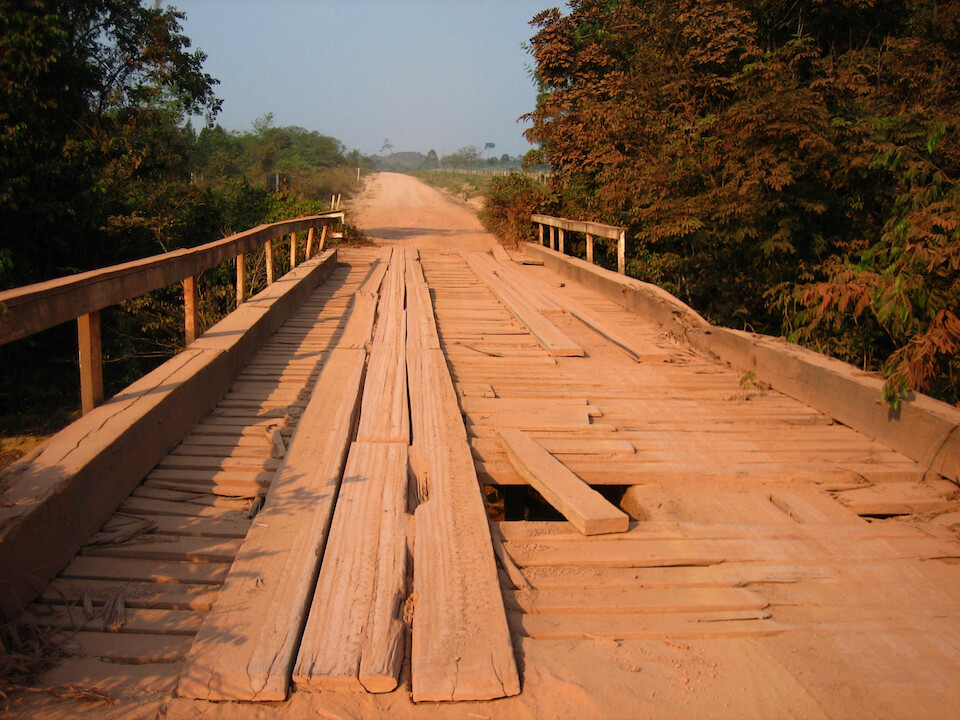 I didn't have to go far to see that the legendary bridges are still out there. Cross planks or not, I guess it's strong enough to support a semi-truck.
I didn't have to go far to see that the legendary bridges are still out there. Cross planks or not, I guess it's strong enough to support a semi-truck.
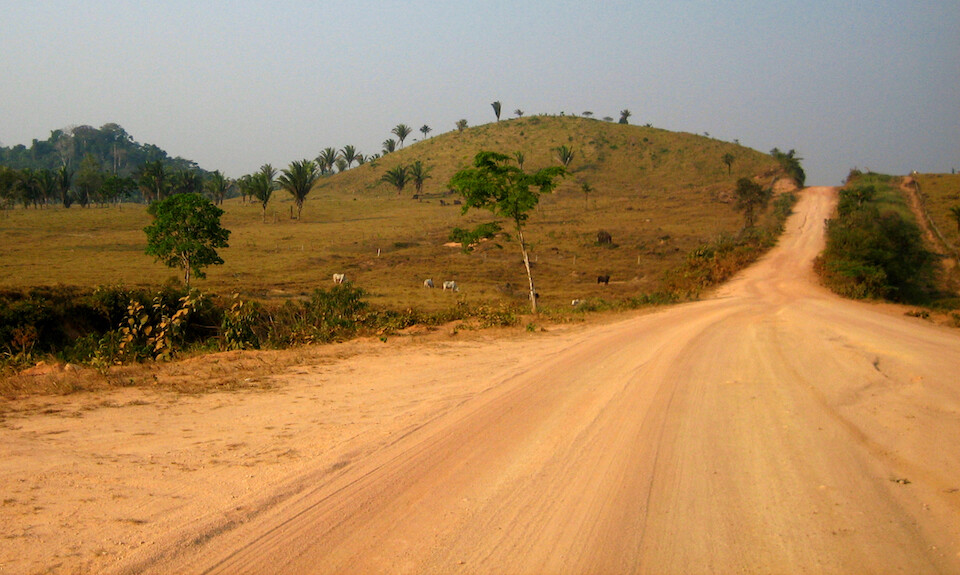 The road got sandy in places, but was generally a pleasant ride. There's also a lot of hills through this region.
The road got sandy in places, but was generally a pleasant ride. There's also a lot of hills through this region.
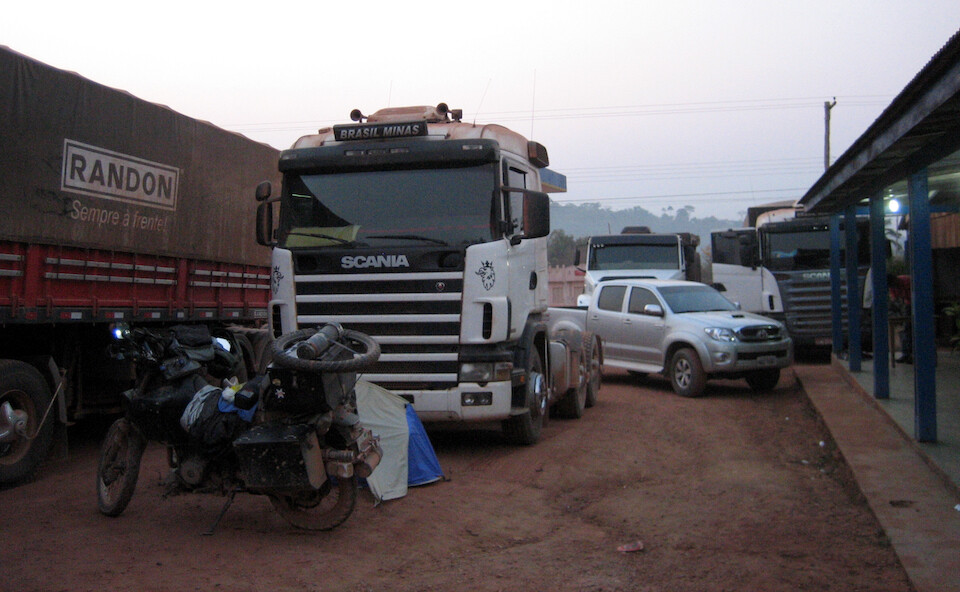 The first town since Humaita is the aptly named settlement of KM 180, being that many kilometers from Humaita. There were hotels, restaurants and petrol stations and most of the travelers stopped here for the night. I camped at this petrol station and the truckers directed me to setup camp between their trucks, which was good since it hid my site from the road.
The first town since Humaita is the aptly named settlement of KM 180, being that many kilometers from Humaita. There were hotels, restaurants and petrol stations and most of the travelers stopped here for the night. I camped at this petrol station and the truckers directed me to setup camp between their trucks, which was good since it hid my site from the road.
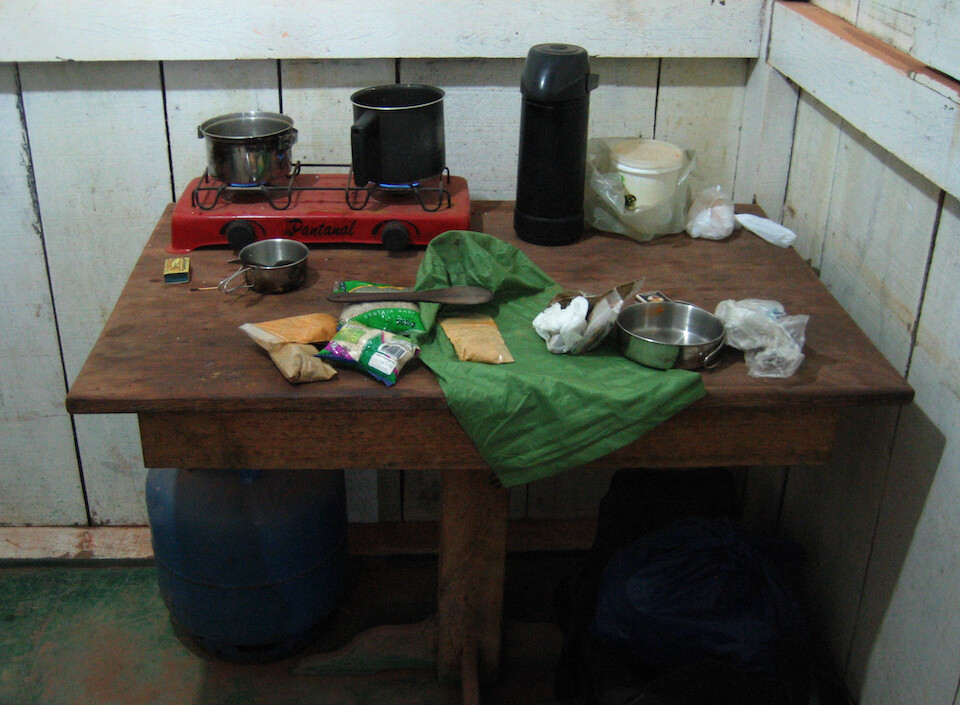 Once again, there were free showers, cold drinking water, laundry facilities (washing sink with soap and clothesline) and a stove for use. I washed my base layers and socks every night and it was amazing to see how much dust was collected in them and hence on my body, as well. I love my Motoport suit since it's all mesh (sturdy kevlar fibers) and keeps me ventilated and protected in hot weather, but the downside is that fine dust particles also get through. I'll take that if it means those dust particles come along with some cooling air for my epidermis.
Once again, there were free showers, cold drinking water, laundry facilities (washing sink with soap and clothesline) and a stove for use. I washed my base layers and socks every night and it was amazing to see how much dust was collected in them and hence on my body, as well. I love my Motoport suit since it's all mesh (sturdy kevlar fibers) and keeps me ventilated and protected in hot weather, but the downside is that fine dust particles also get through. I'll take that if it means those dust particles come along with some cooling air for my epidermis.
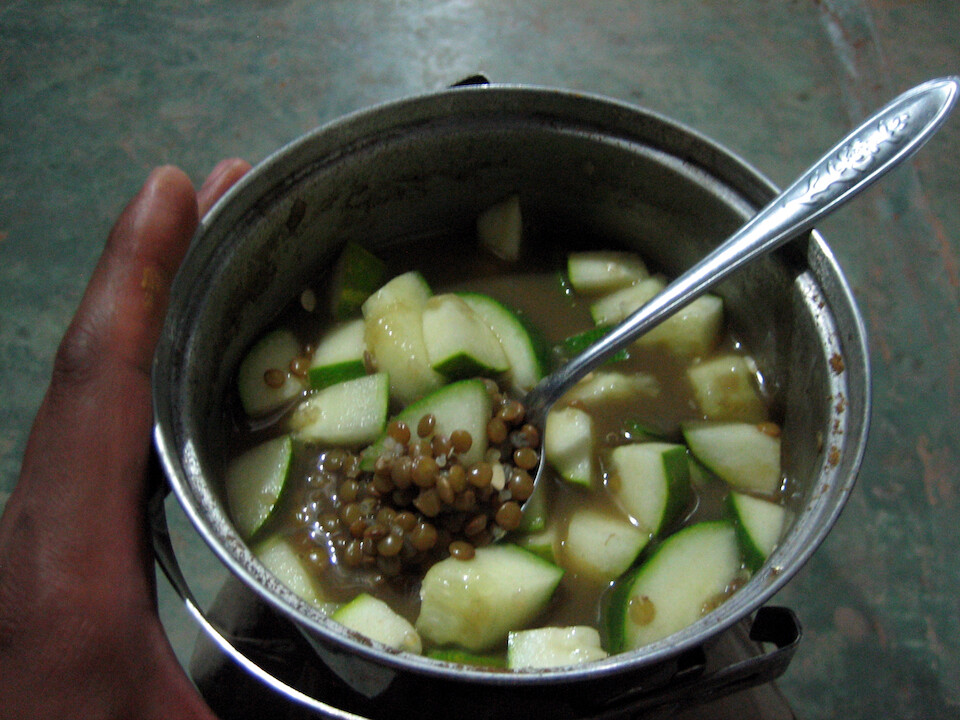 I made some lentils with a cucumber that I was carrying since Rurrenabaque in Bolivia. Oooh, I smuggled a vegetable across an international border (it's a big no-no to transport possible disease-carrying produce across borders). The cucumber was refreshing and hydrating. A simple meal of lean proteins with fibrous carbohydrates. What more does the body need? (A range of vitamins and minerals, for sure.) The truckers got a kick out of seeing what this strange biker was having for dinner.
I made some lentils with a cucumber that I was carrying since Rurrenabaque in Bolivia. Oooh, I smuggled a vegetable across an international border (it's a big no-no to transport possible disease-carrying produce across borders). The cucumber was refreshing and hydrating. A simple meal of lean proteins with fibrous carbohydrates. What more does the body need? (A range of vitamins and minerals, for sure.) The truckers got a kick out of seeing what this strange biker was having for dinner.
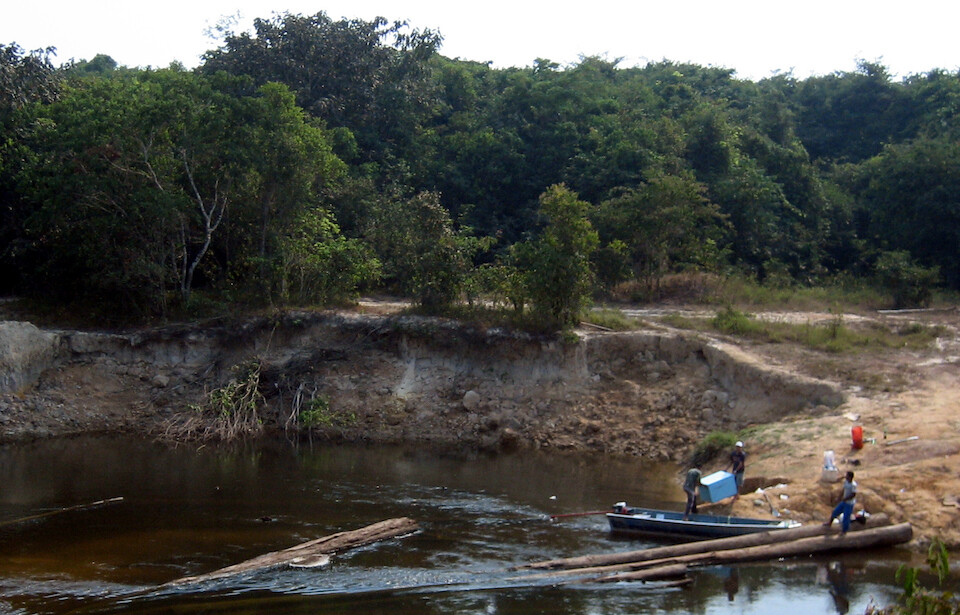 After a good night's sleep of over 10 hours and guzzling lots of cold water, I headed out towards Apui. Transporting logs down a river.
After a good night's sleep of over 10 hours and guzzling lots of cold water, I headed out towards Apui. Transporting logs down a river.
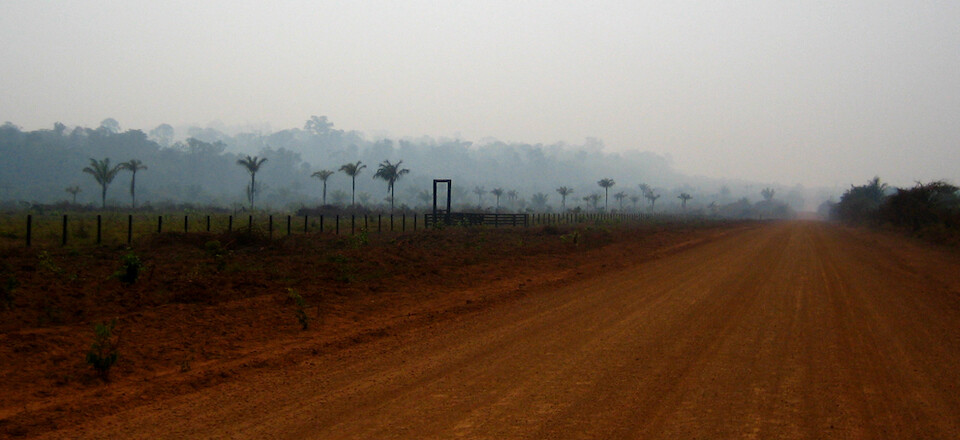 More smoke from the ongoing burning of the Amazon. The gateway to the fazenda might point to who could be responsible for this. But truth be told, all of us who consume beef share some responsibility for the destruction of the Amazon and other forests. Our actions on the dinner plate are not isolated but interconnected on a vast scale. You know I love a rare steak, but is it a justified craving when people around the world aspire to consume more beef as they progress up the development ladder?
More smoke from the ongoing burning of the Amazon. The gateway to the fazenda might point to who could be responsible for this. But truth be told, all of us who consume beef share some responsibility for the destruction of the Amazon and other forests. Our actions on the dinner plate are not isolated but interconnected on a vast scale. You know I love a rare steak, but is it a justified craving when people around the world aspire to consume more beef as they progress up the development ladder?
 Every now and then the route passed an opening in the foliage to reveal a pond, providing a refreshing view of agua - a respite from the dusty road.
Every now and then the route passed an opening in the foliage to reveal a pond, providing a refreshing view of agua - a respite from the dusty road.
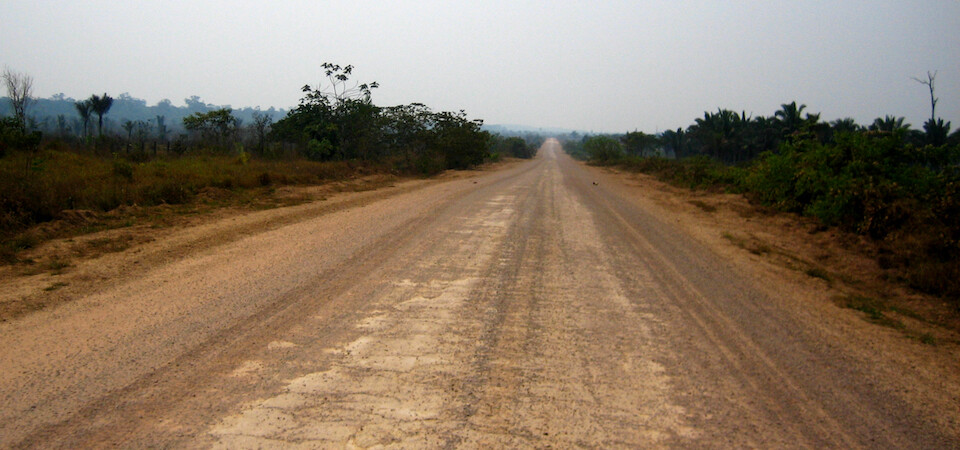 The road surface varied from hard-packed mud like this to loose gravel and sand, but mostly it was well-maintained.
The road surface varied from hard-packed mud like this to loose gravel and sand, but mostly it was well-maintained.
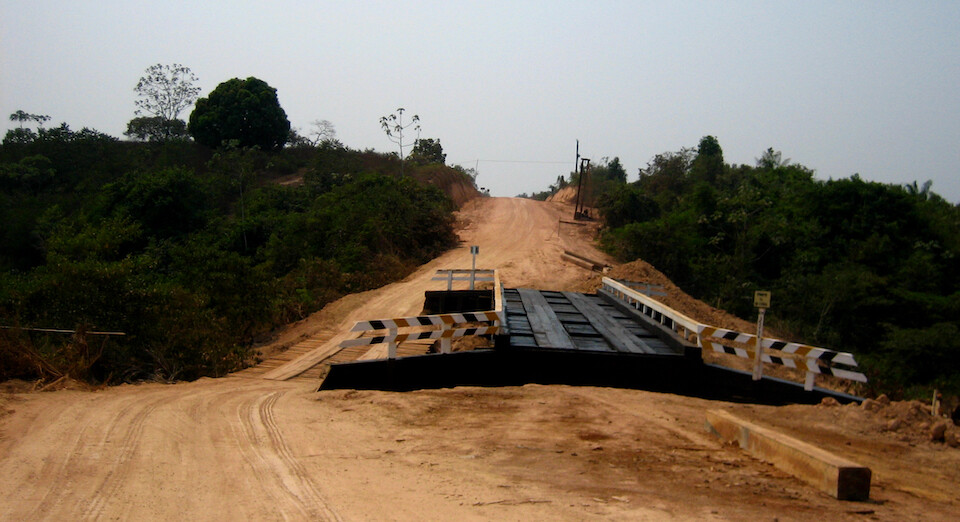 Constructing a new bridge, with the old one not having any guard rails, so don't fall over.
Constructing a new bridge, with the old one not having any guard rails, so don't fall over.
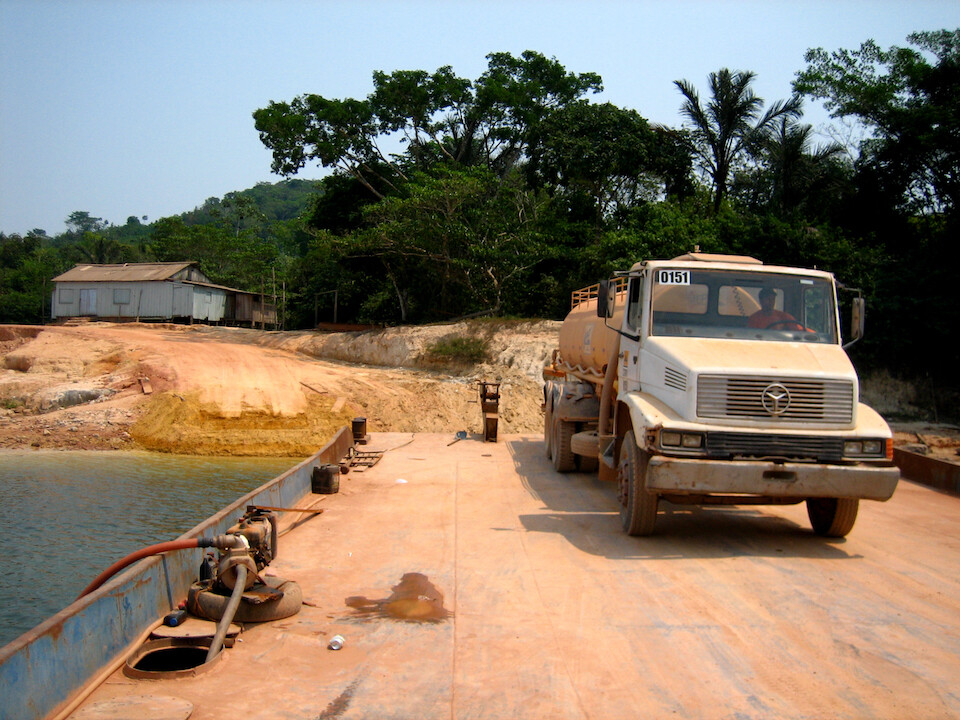 I rolled up to this ferry just as it was about to leave. As you can see, the only other traffic on this road was supply trucks of fuel and other products. Fuel was available about every 200 kms (125 mi), except one section further ahead where a 400 km (248 mi) range is needed.
I rolled up to this ferry just as it was about to leave. As you can see, the only other traffic on this road was supply trucks of fuel and other products. Fuel was available about every 200 kms (125 mi), except one section further ahead where a 400 km (248 mi) range is needed.
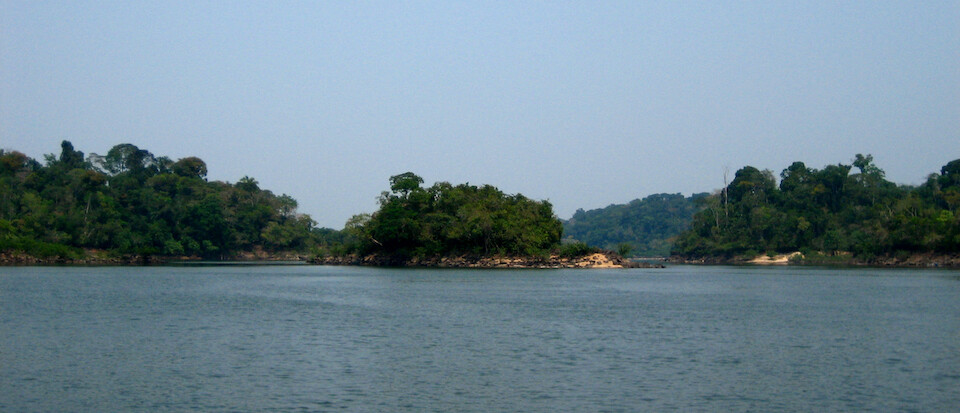 Crossing Rio Aripuana, a tributary flowing into the Rio Madeira and onto Rio Amazonas.
Crossing Rio Aripuana, a tributary flowing into the Rio Madeira and onto Rio Amazonas.
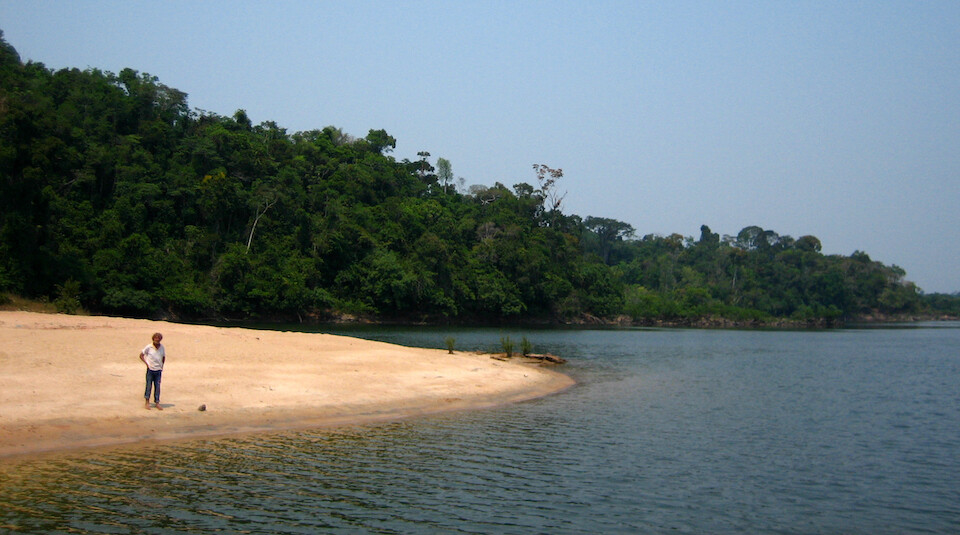 An inviting beach on the shores of Rio Aripuana.
An inviting beach on the shores of Rio Aripuana.
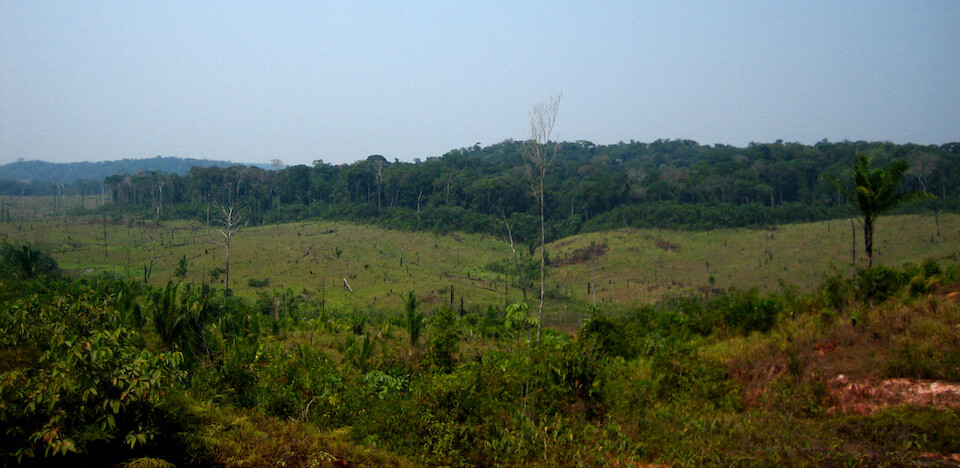 Looking across a wide valley with the original forest kept intact at the top of the relief. This same method of conservation was used in many places, where it appears the government has allowed the forest to be cleared up to a certain point on hills and preserved a small area on the top for the fauna and flora. While the intention to conserve like this might be a good compromise, habitat isolation and islandization perpetuate the reduction of biodiversity. However, it's encouraging that governments around the world are now recognizing the need to connect all these isolated preserves to create a corridor and networks for the animals to move through and keep a healthy ecosystem intact upon which we all depend on.
Looking across a wide valley with the original forest kept intact at the top of the relief. This same method of conservation was used in many places, where it appears the government has allowed the forest to be cleared up to a certain point on hills and preserved a small area on the top for the fauna and flora. While the intention to conserve like this might be a good compromise, habitat isolation and islandization perpetuate the reduction of biodiversity. However, it's encouraging that governments around the world are now recognizing the need to connect all these isolated preserves to create a corridor and networks for the animals to move through and keep a healthy ecosystem intact upon which we all depend on.
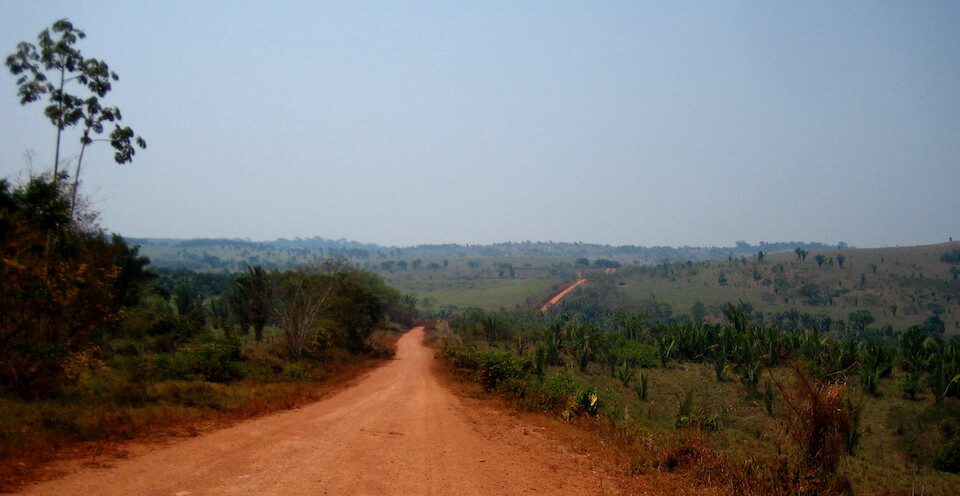 The TransAmazonica following the contours of the land.
The TransAmazonica following the contours of the land.
 It was starting to get more hilly and predictably, at the trough would be a bridge with sandy sections on either side. I slowed to a stop for every bridge because there was usually a pot hole or depression leading to the wooden planks, probably from the truck tires.
It was starting to get more hilly and predictably, at the trough would be a bridge with sandy sections on either side. I slowed to a stop for every bridge because there was usually a pot hole or depression leading to the wooden planks, probably from the truck tires.
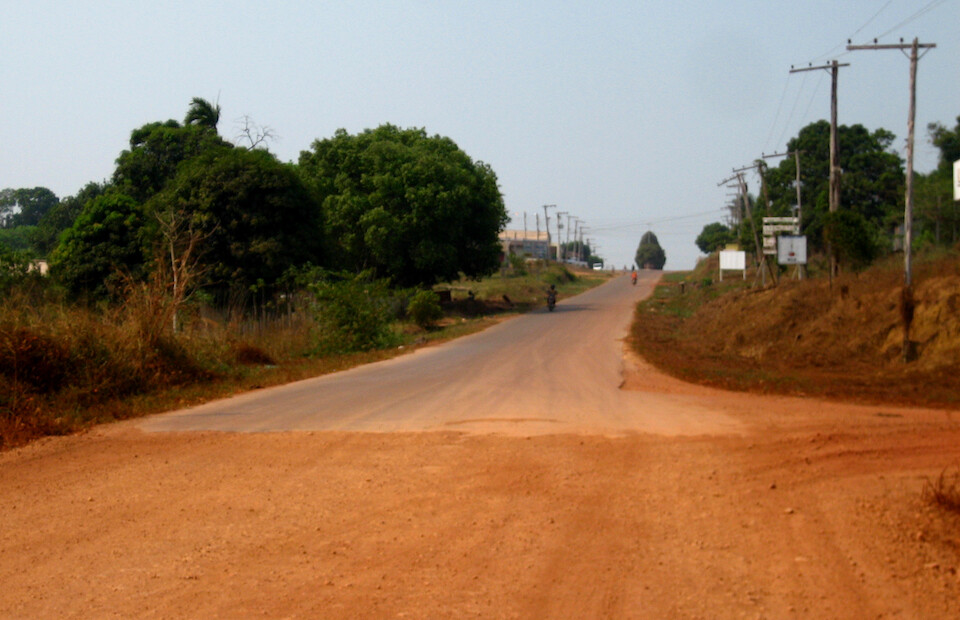 Reaching Apui, the biggest town between Humaita and Itaituba. I had covered 400 kms (248 mi) from Humaita and was told by locals that the next 700 kms (435 mi) to Itaituba was the toughest section of the route and most isolated, with trucks going no further. Feeling good about the riding so far, I was looking forward to it.
Reaching Apui, the biggest town between Humaita and Itaituba. I had covered 400 kms (248 mi) from Humaita and was told by locals that the next 700 kms (435 mi) to Itaituba was the toughest section of the route and most isolated, with trucks going no further. Feeling good about the riding so far, I was looking forward to it.
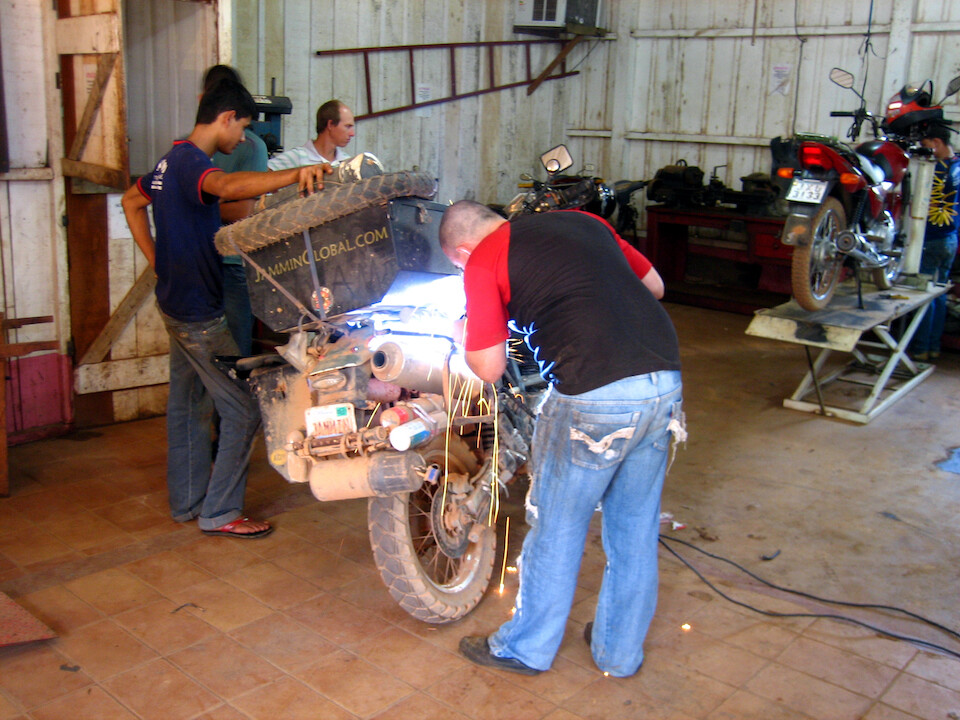 The weld job in Bolivia of my pannier frame wasn't holding up, so I got it retouched at this Honda shop for RUSD 5.
The weld job in Bolivia of my pannier frame wasn't holding up, so I got it retouched at this Honda shop for RUSD 5.
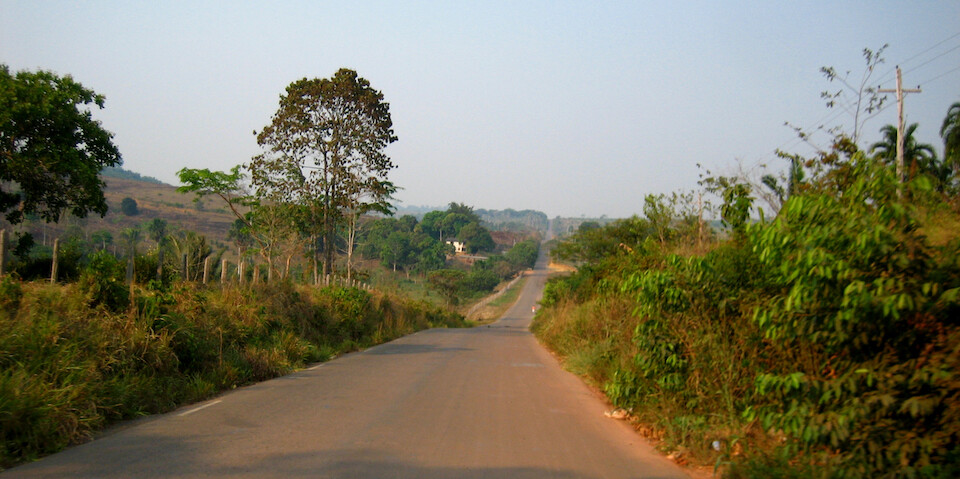 After stocking up on some groceries (oatmeal, pasta and tomato sauce) and posting some updates to the outside world, I hit the road.
After stocking up on some groceries (oatmeal, pasta and tomato sauce) and posting some updates to the outside world, I hit the road.
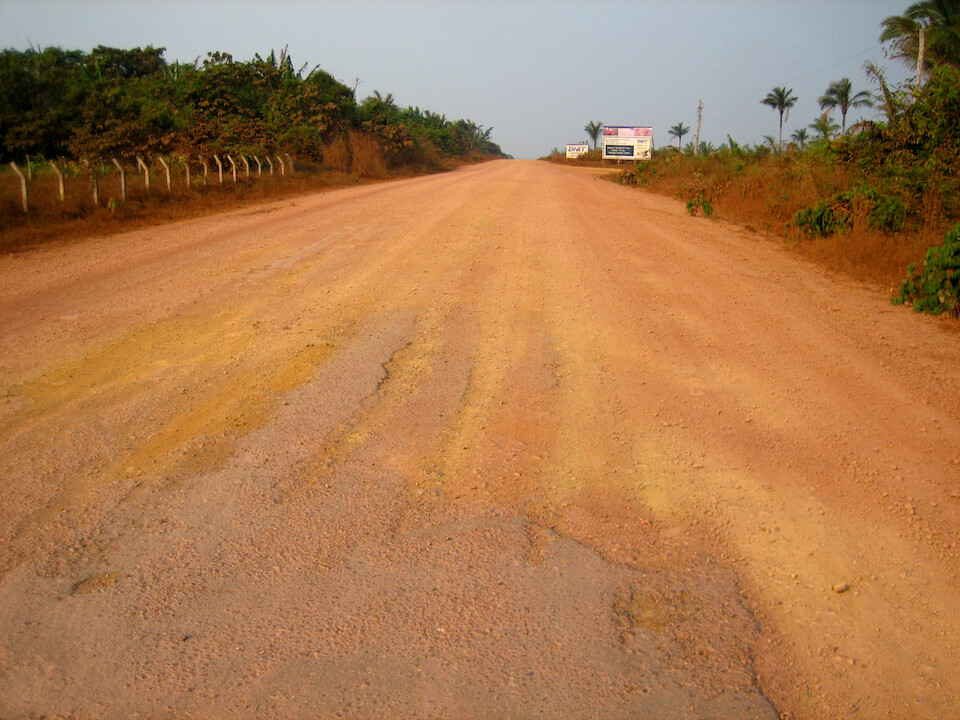 While the asphalt might've been a relief for a while, I was looking forward to the dirt since I was running less air pressure in my tires for the off-road conditions, which would be heating up the rubber and wearing faster on the pavement.
While the asphalt might've been a relief for a while, I was looking forward to the dirt since I was running less air pressure in my tires for the off-road conditions, which would be heating up the rubber and wearing faster on the pavement.
 After an hour's ride, I came across this fazenda and asked the rancher sitting out front if I could camp here for the night. I practiced the phrase a couple times from my Lonely Planet phrasebook and was pleased to be communicating in Portuguese soon after entering Brazil. The rancher's house is on the left and I camped next to the work shed. Click here
to see the high resolution version.
After an hour's ride, I came across this fazenda and asked the rancher sitting out front if I could camp here for the night. I practiced the phrase a couple times from my Lonely Planet phrasebook and was pleased to be communicating in Portuguese soon after entering Brazil. The rancher's house is on the left and I camped next to the work shed. Click here
to see the high resolution version.
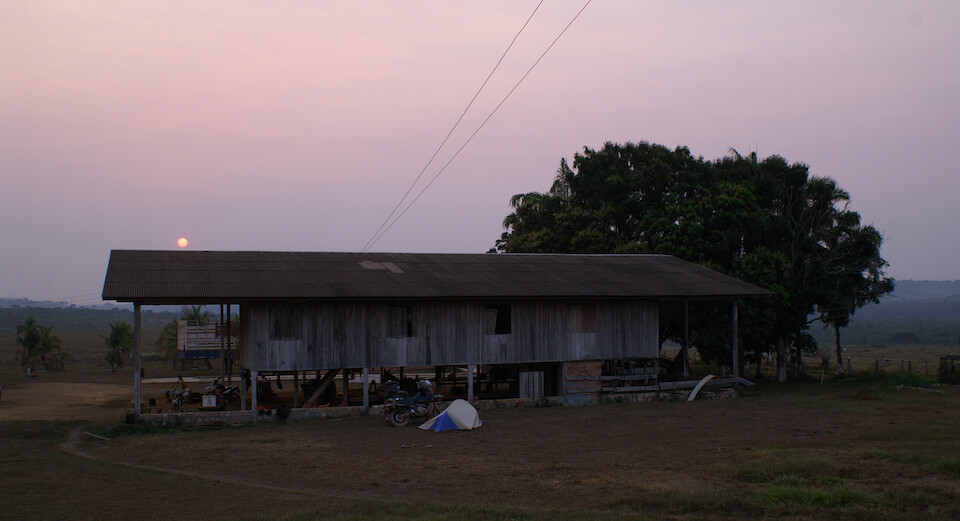 After a refreshing cold shower, I enjoyed the sunset while walking around the fazenda.
After a refreshing cold shower, I enjoyed the sunset while walking around the fazenda.
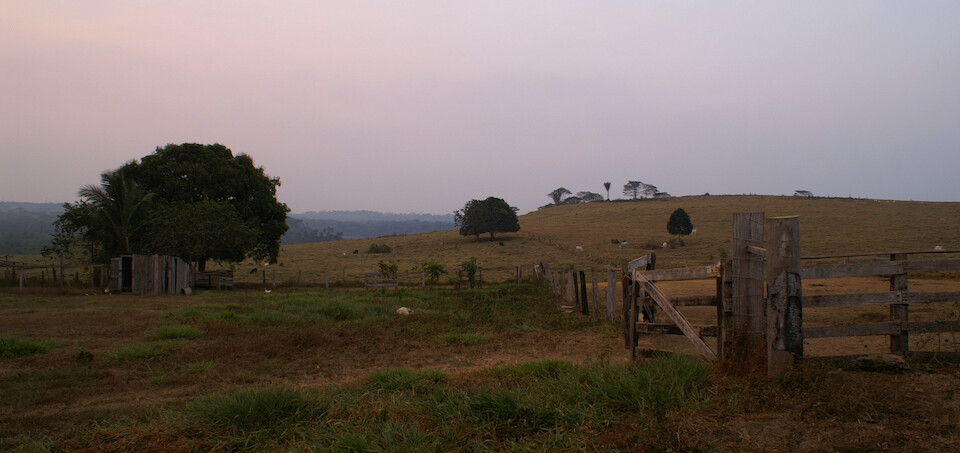 It's primarily a cattle ranch.
It's primarily a cattle ranch.
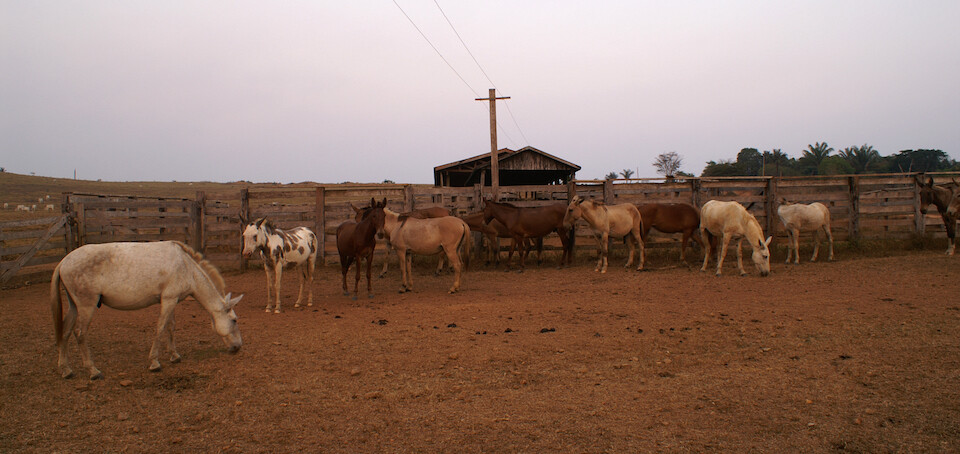 Plus he's also breeding mules.
Plus he's also breeding mules.
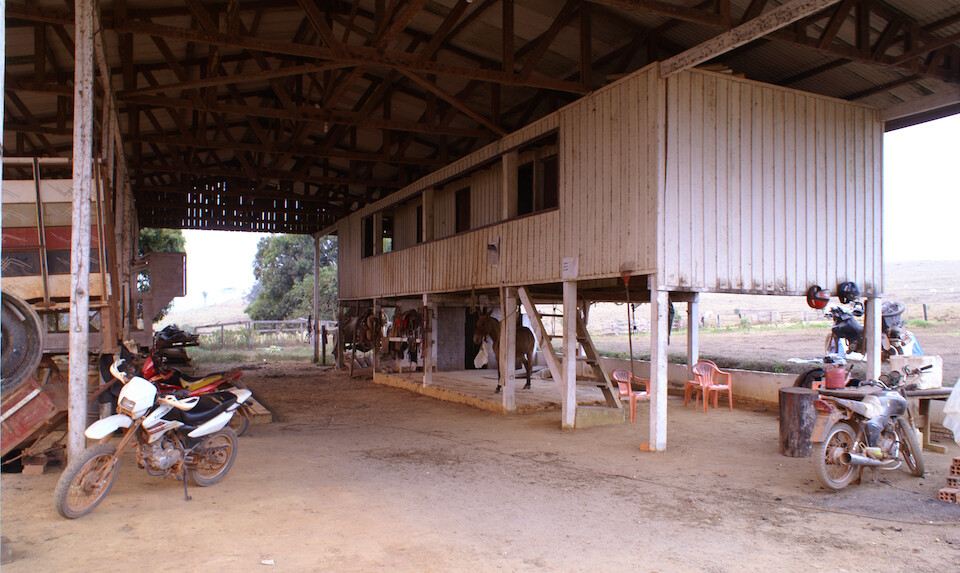 The work shed where the mules got their shoes put on. Those bikes are 250 cc Honda Tornadoes, made in Brazil and popular all over South America.
The work shed where the mules got their shoes put on. Those bikes are 250 cc Honda Tornadoes, made in Brazil and popular all over South America.
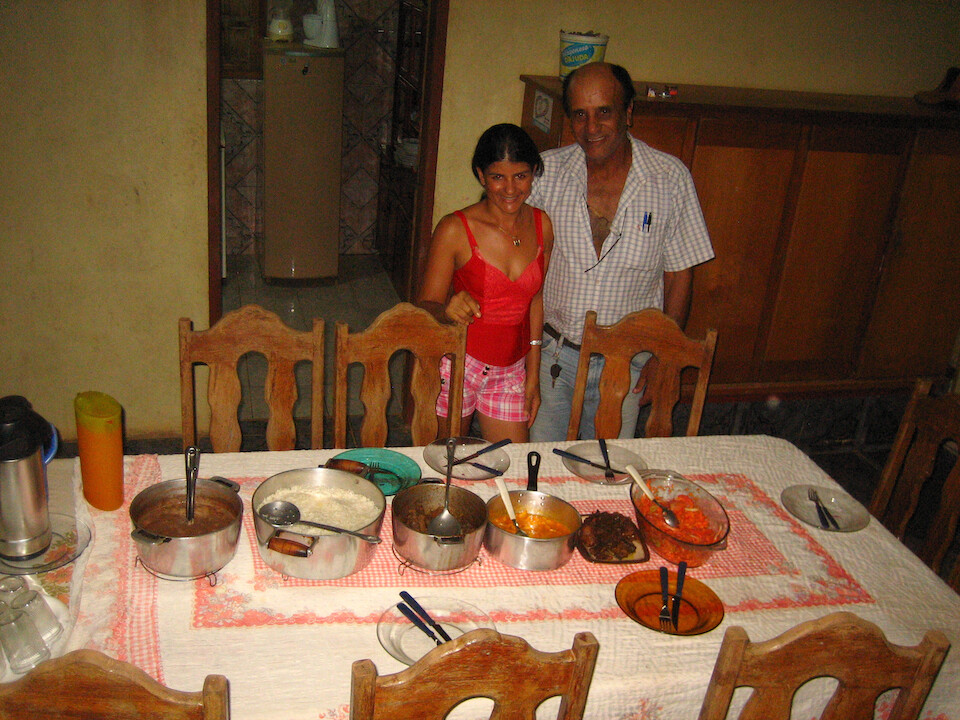 Rancher Jose and his wife inviting me to share dinner with them and his farmhands. There was rice, beans, veggies, some beef and a salad. He was intrigued with India and had lots of questions about the culture and the politics and it was interesting to hear his story. The government gave him an incentive to move out here 10 years ago to create pastureland for cattle and he had a successful operation going. But now the government, feeling pressures from the international community to preserve more of the Amazon, is starting to hamper his business. Elections for the new Brazilian president were coming up in six weeks and campaigning was in full force throughout the country. I tried to get a feel for the issues but only managed to grasp the gist of his talk. He thanked me for stopping by his house since he never met an Indian before and wanted to know more since our two countries are forming a strong bond in the international arena.
Rancher Jose and his wife inviting me to share dinner with them and his farmhands. There was rice, beans, veggies, some beef and a salad. He was intrigued with India and had lots of questions about the culture and the politics and it was interesting to hear his story. The government gave him an incentive to move out here 10 years ago to create pastureland for cattle and he had a successful operation going. But now the government, feeling pressures from the international community to preserve more of the Amazon, is starting to hamper his business. Elections for the new Brazilian president were coming up in six weeks and campaigning was in full force throughout the country. I tried to get a feel for the issues but only managed to grasp the gist of his talk. He thanked me for stopping by his house since he never met an Indian before and wanted to know more since our two countries are forming a strong bond in the international arena.
Next: Brazil, Part 2: Riding the depths of the TransAmazonica